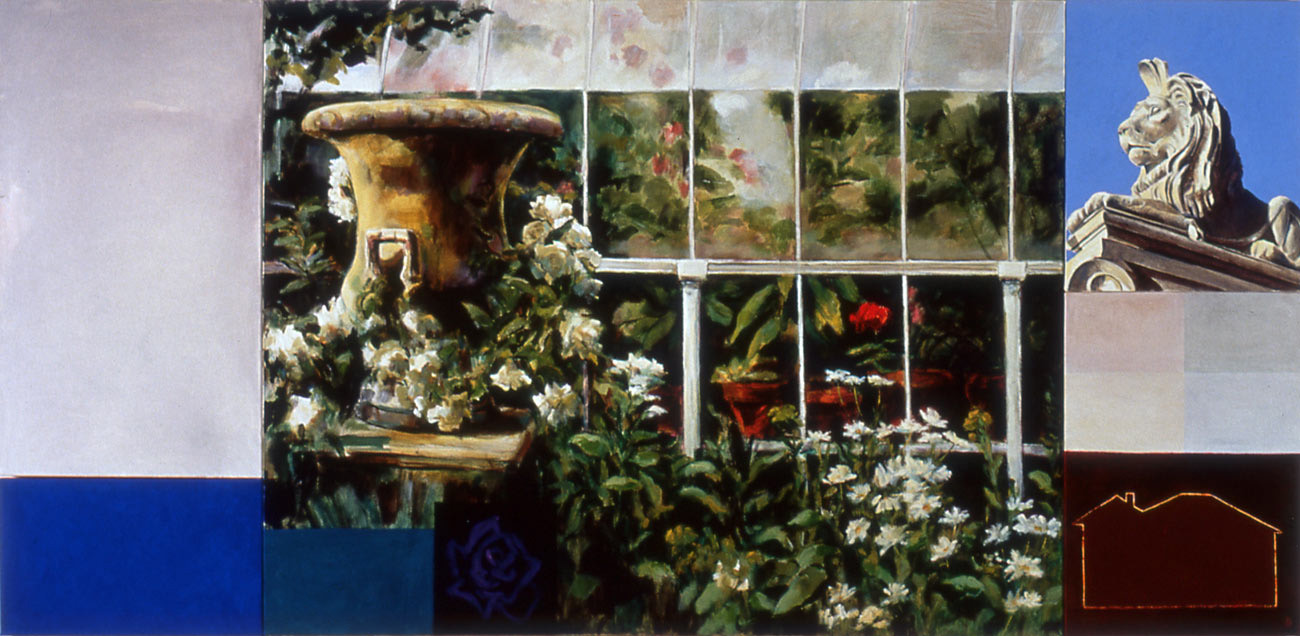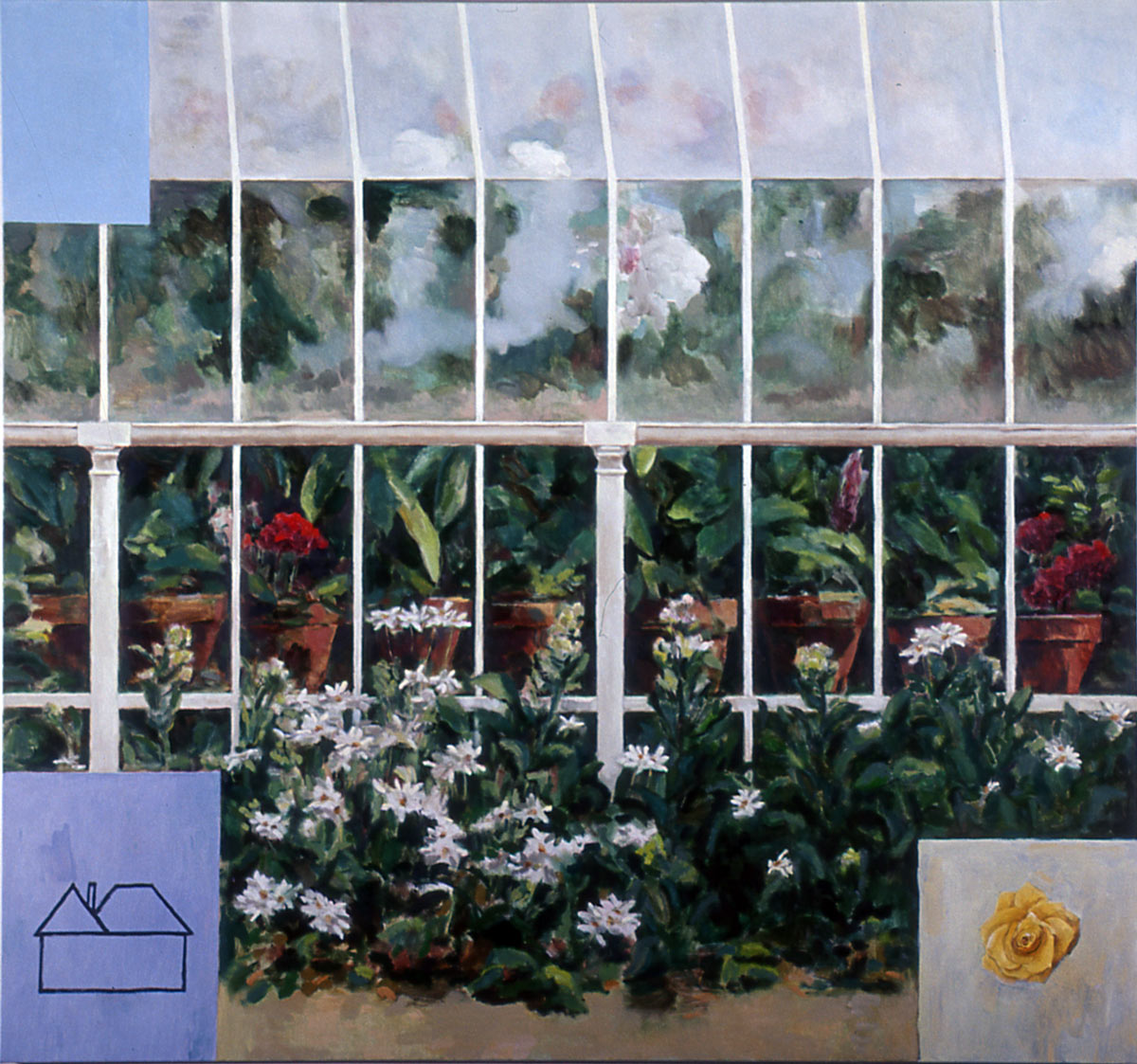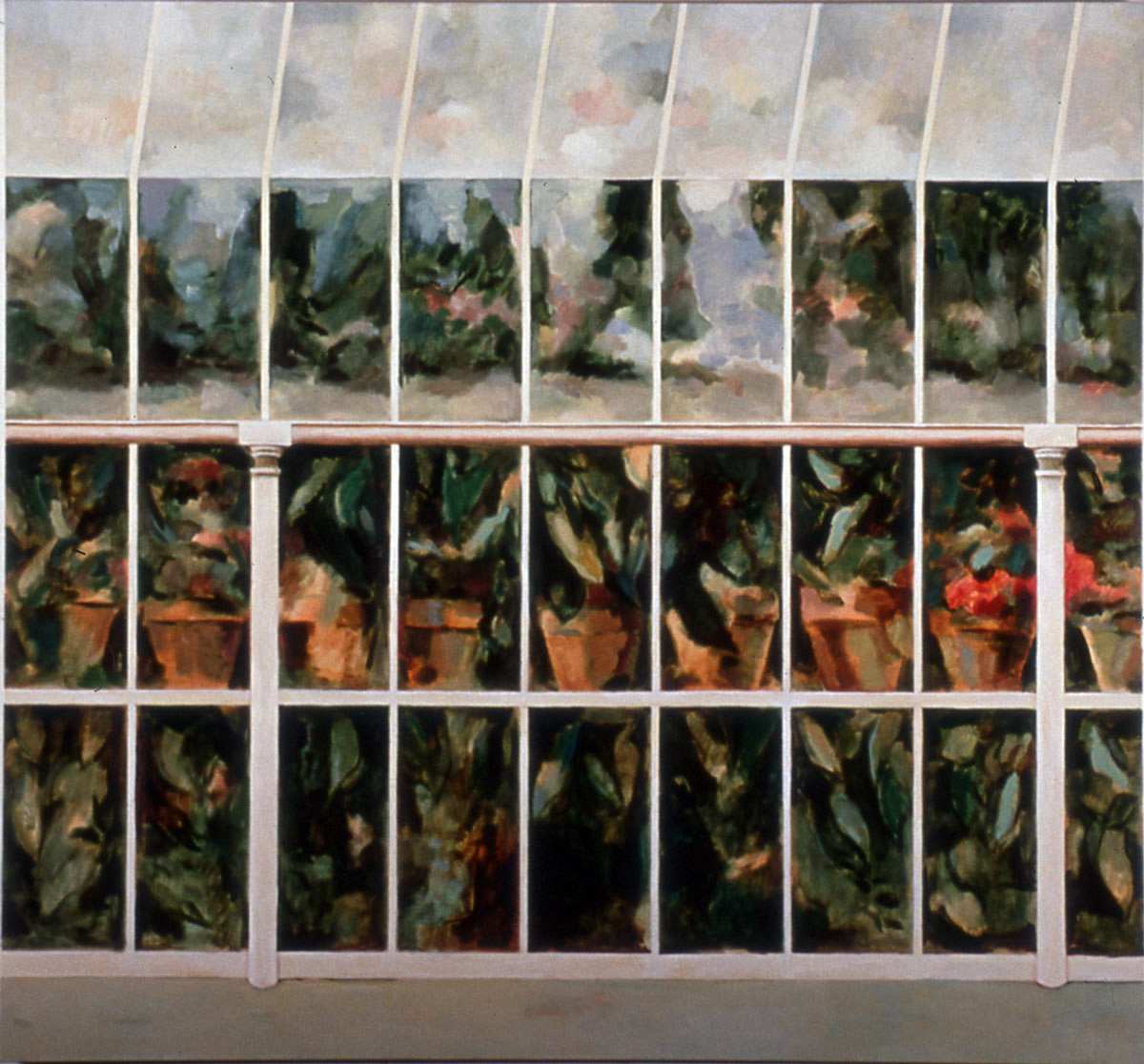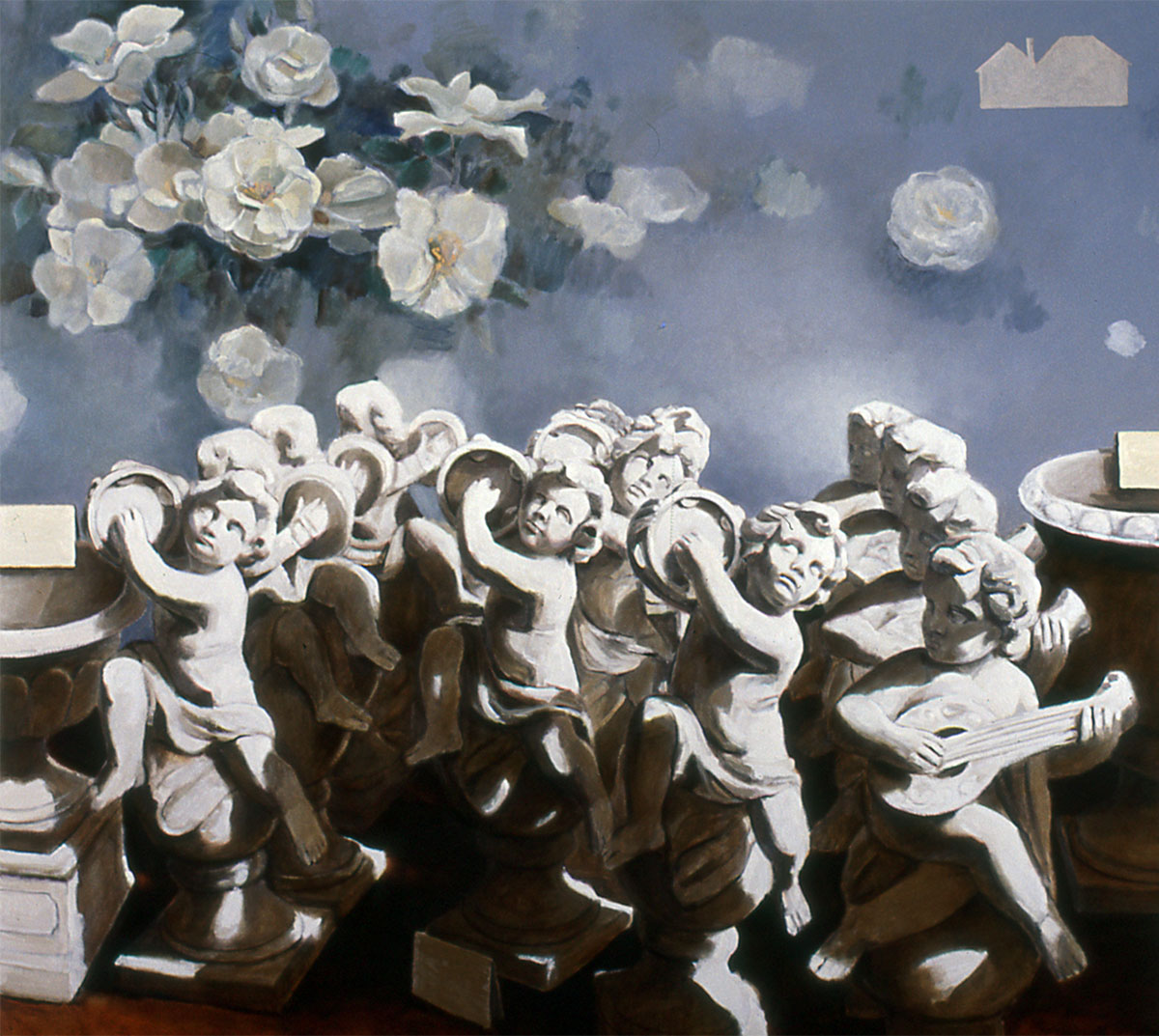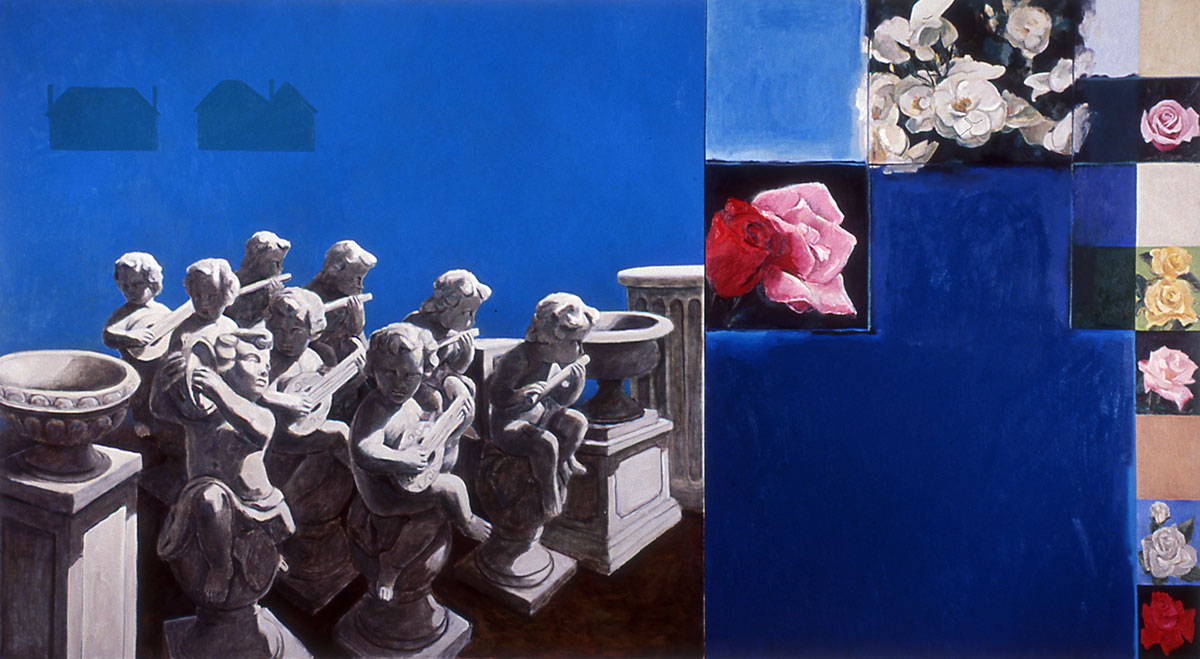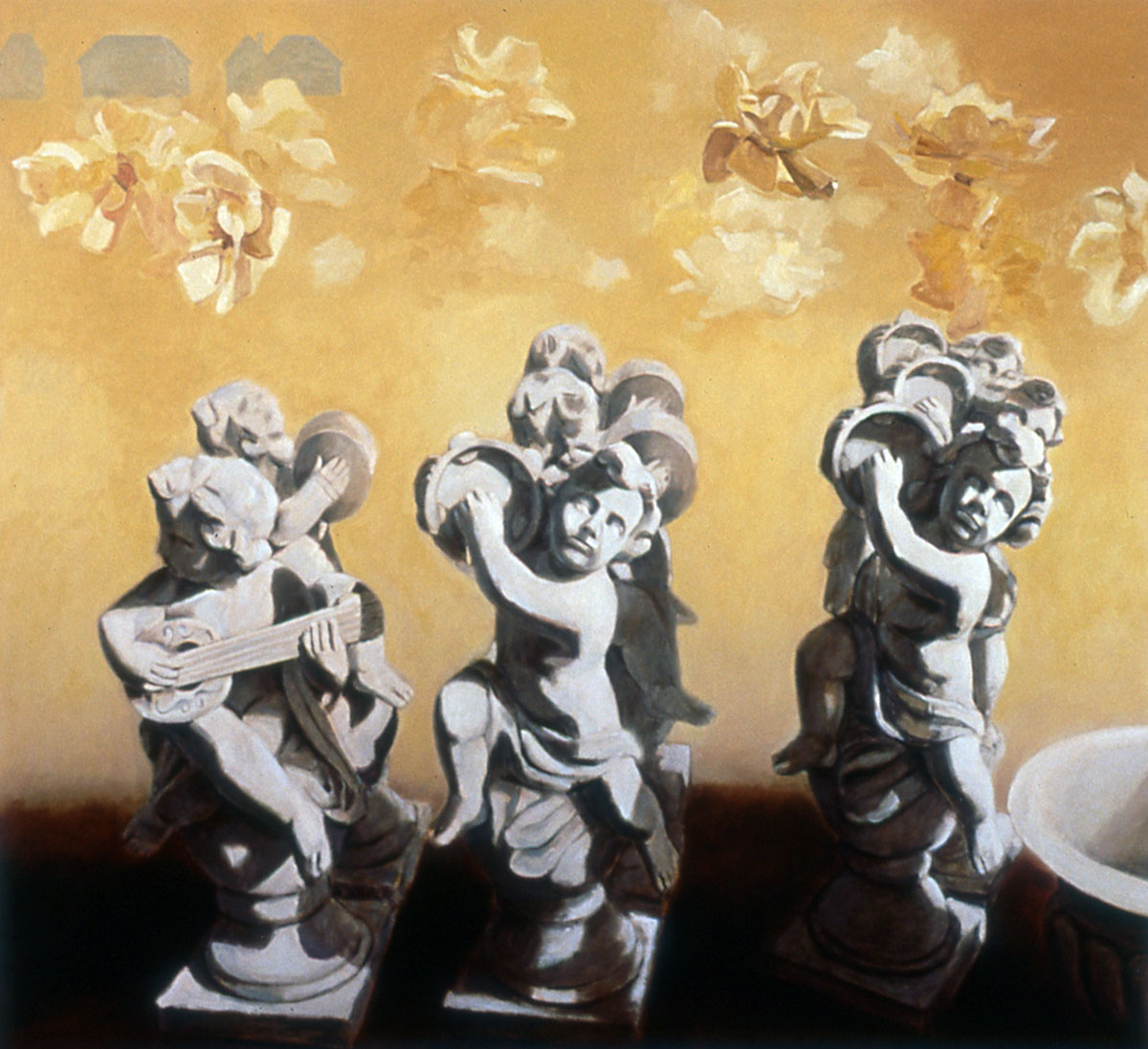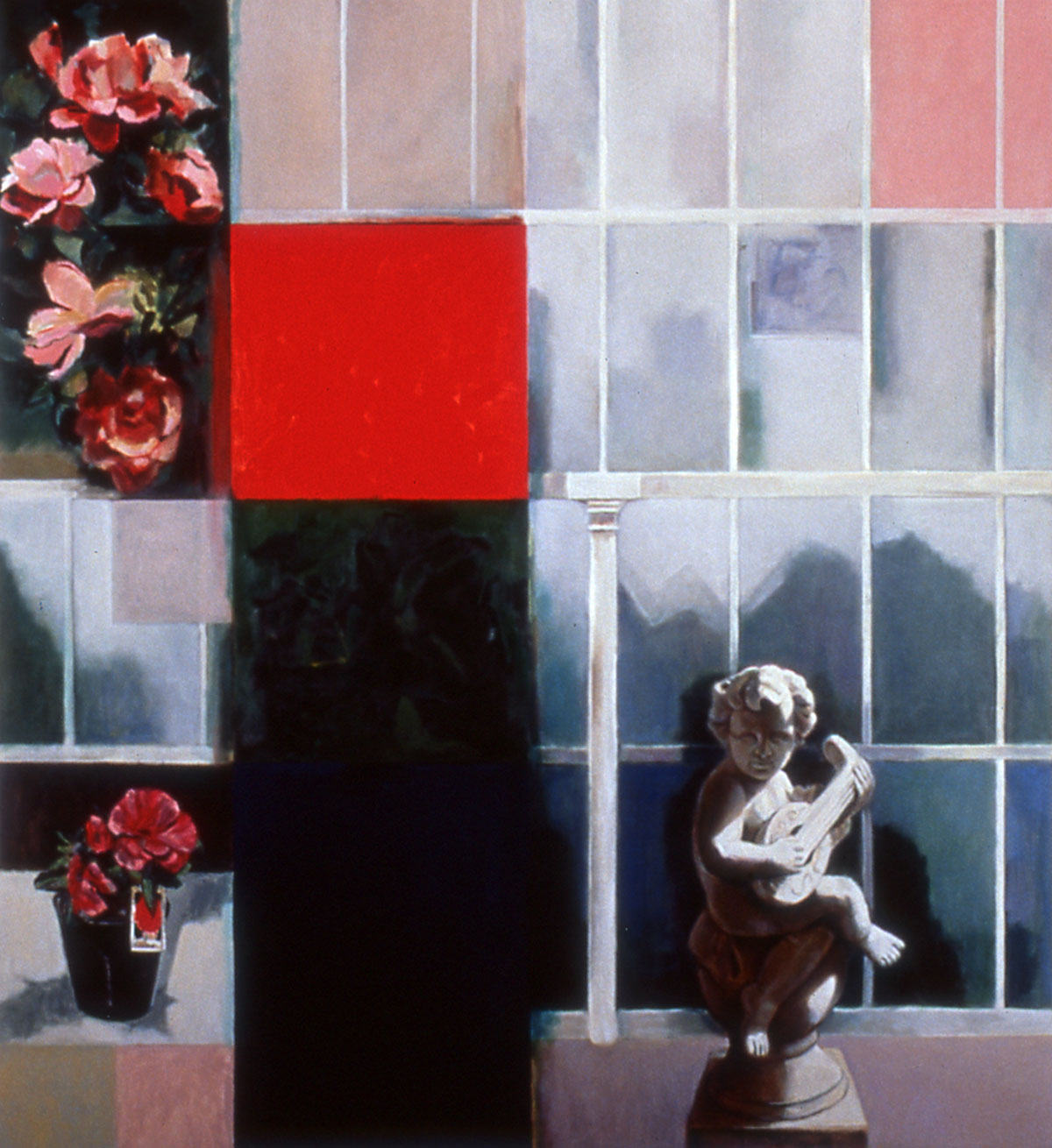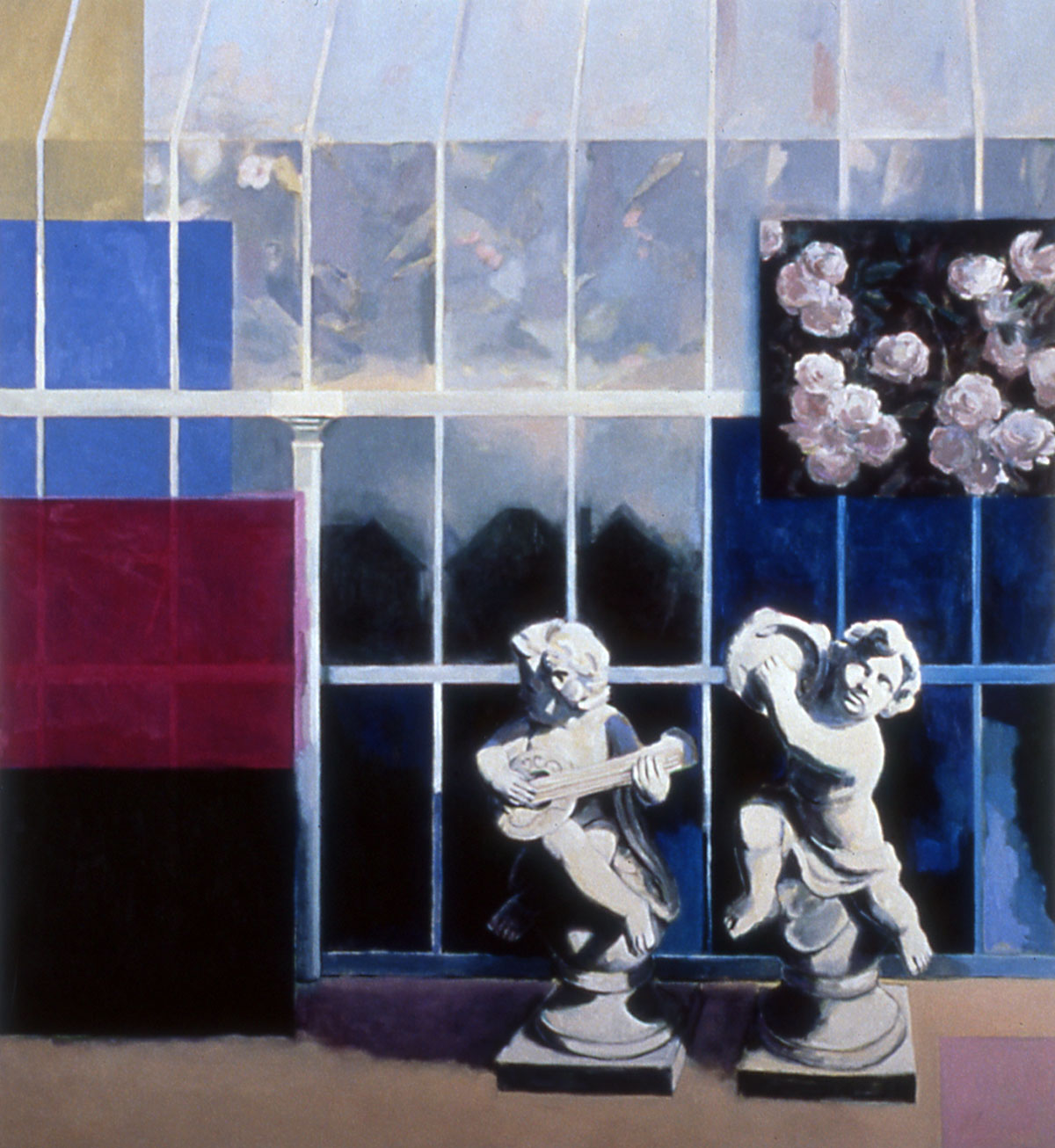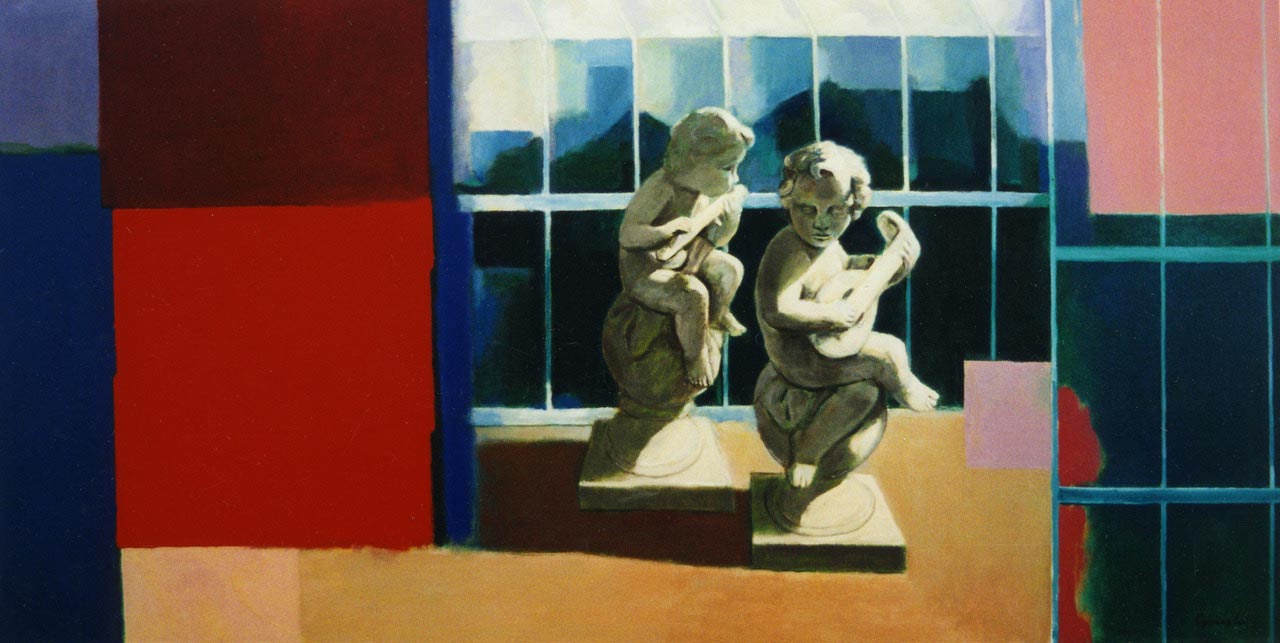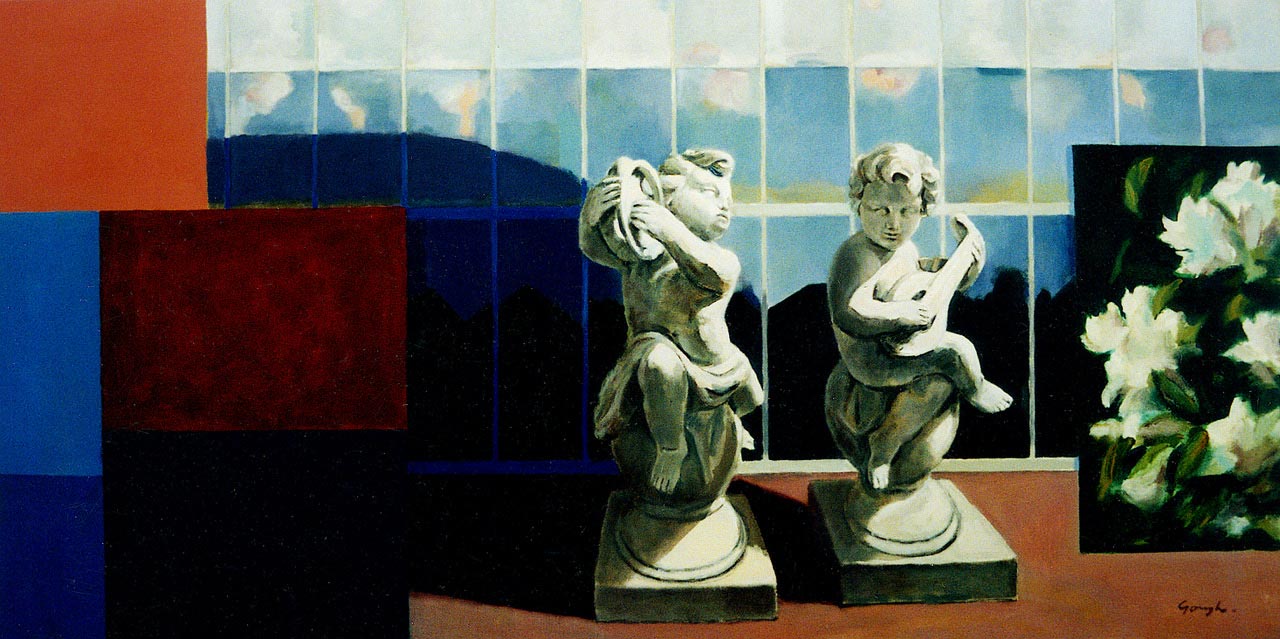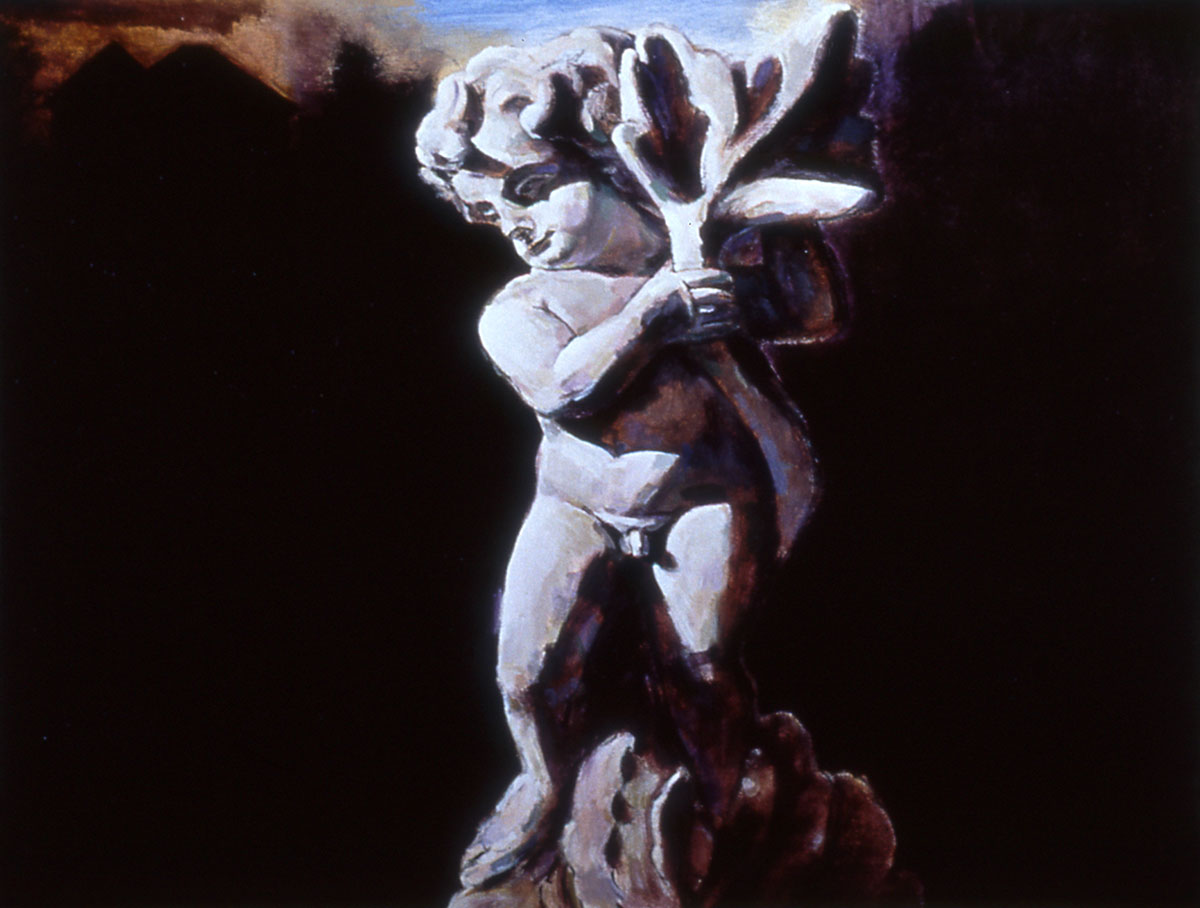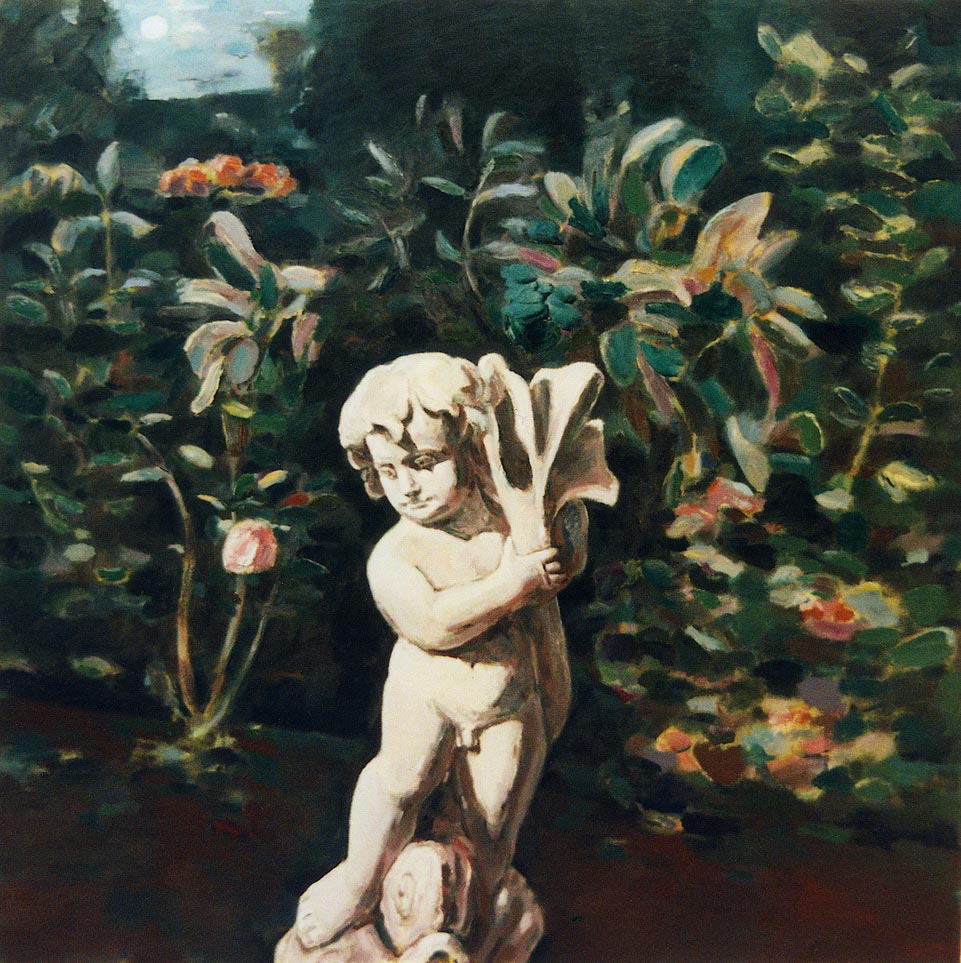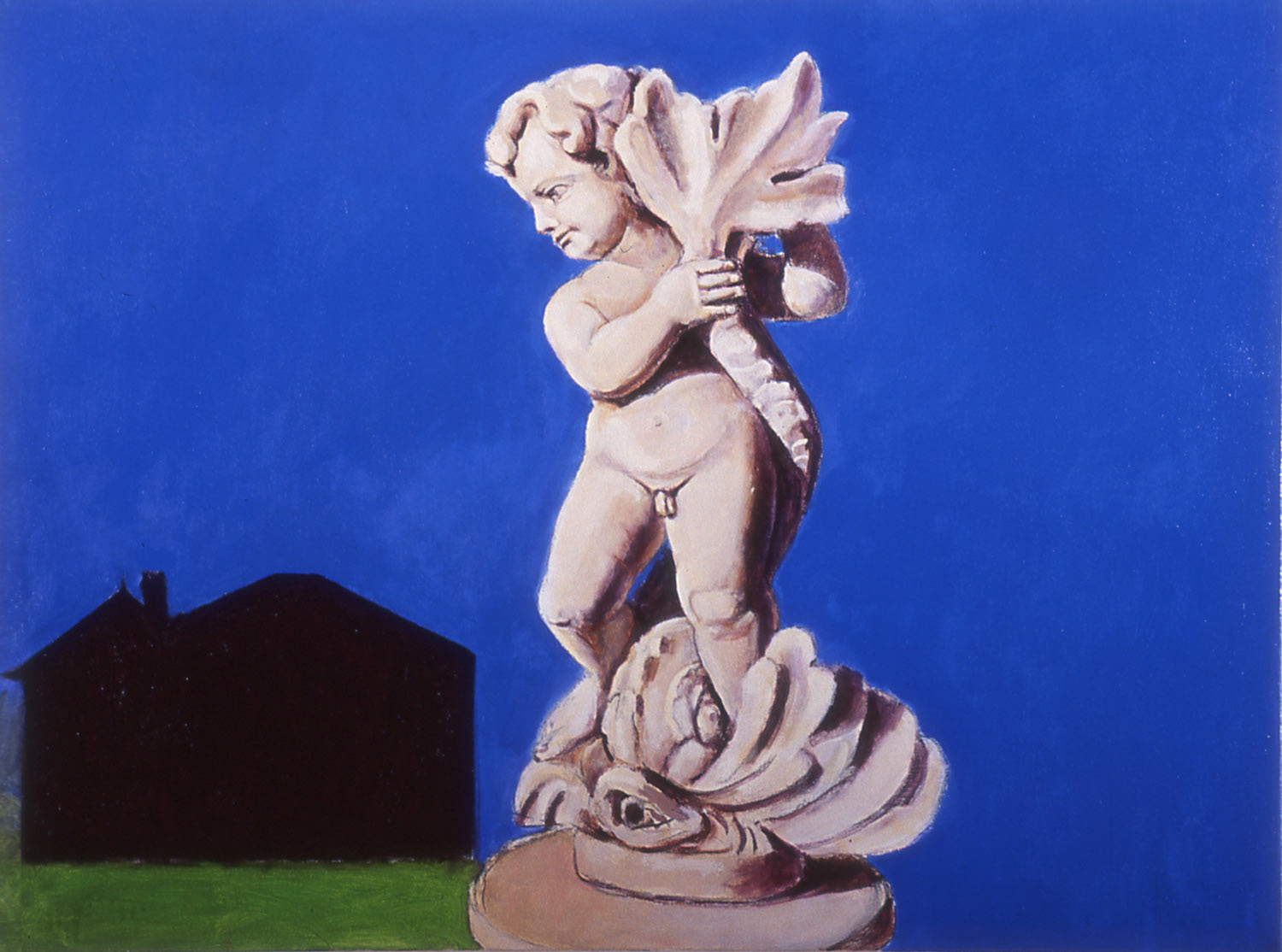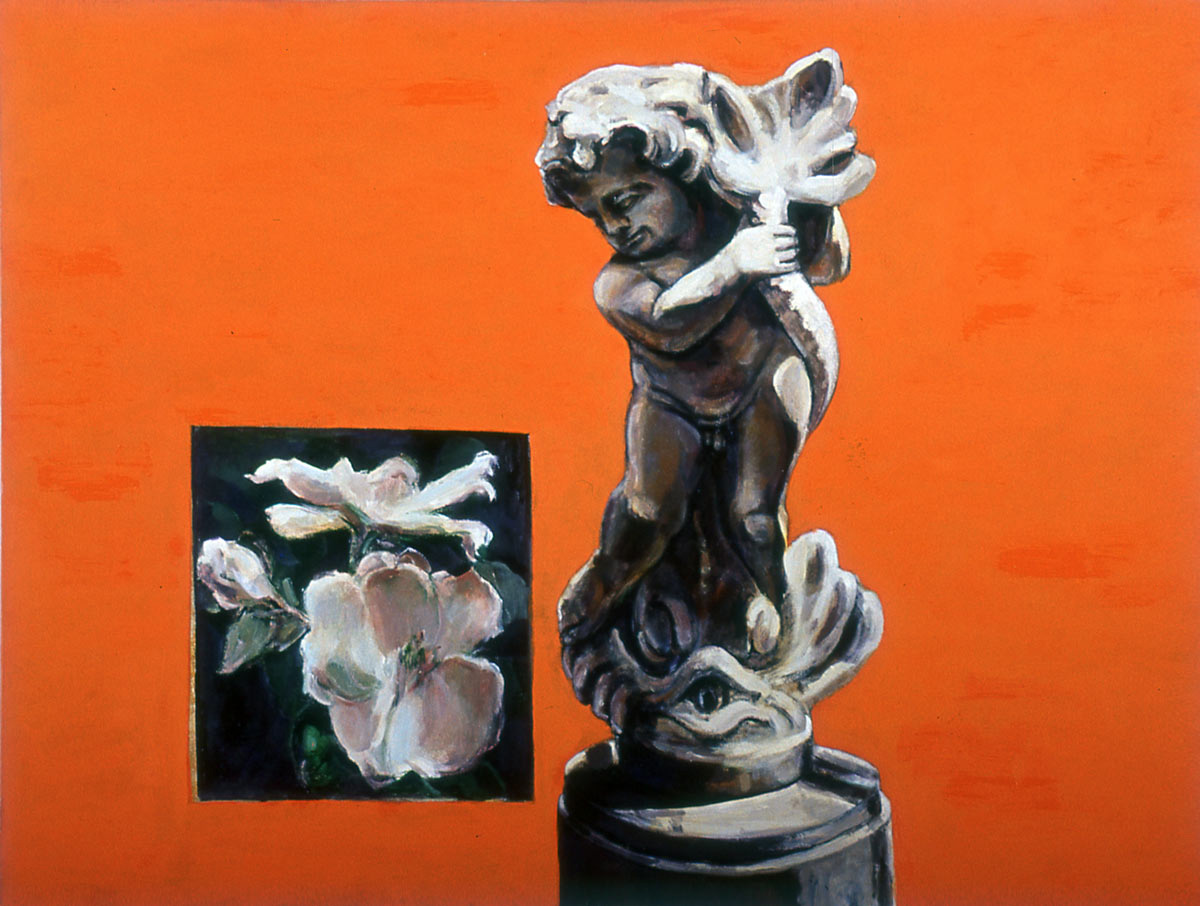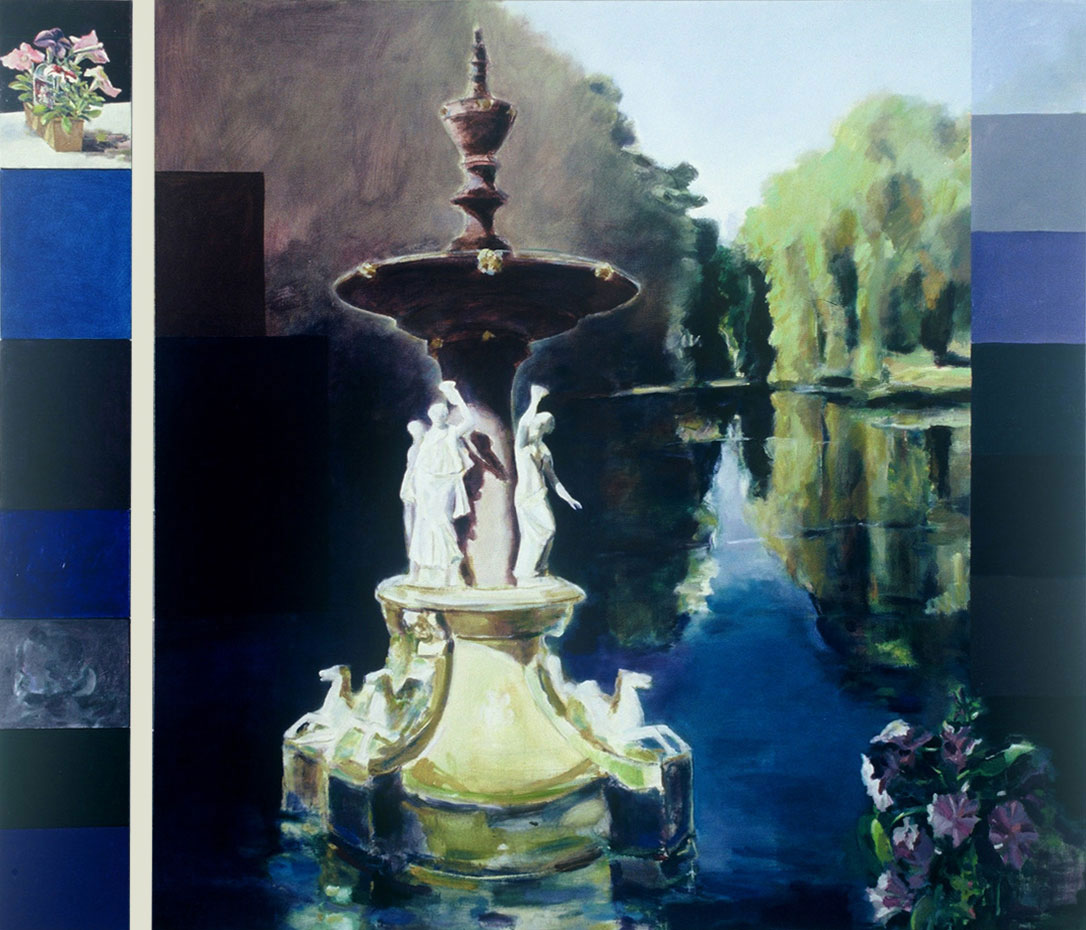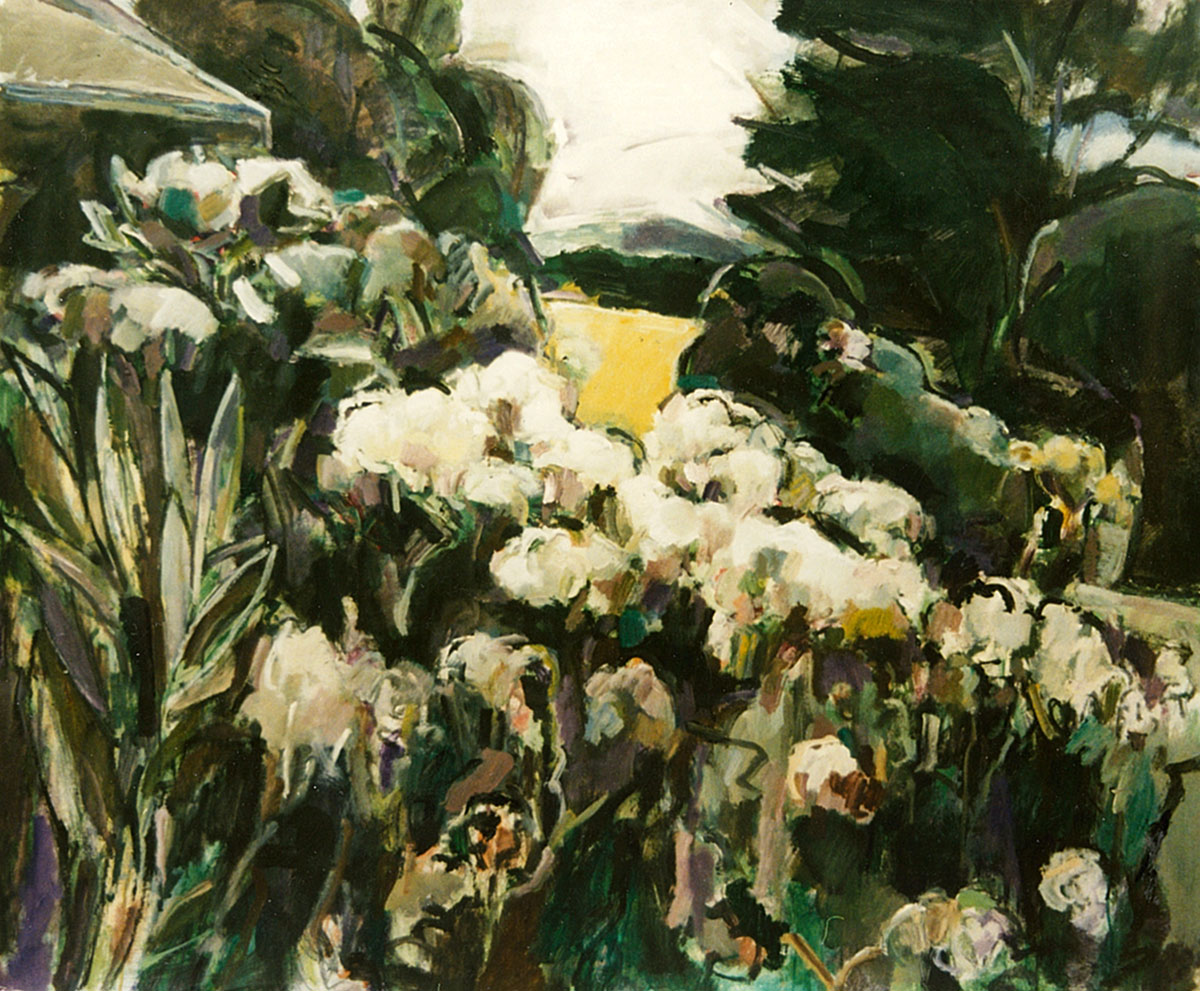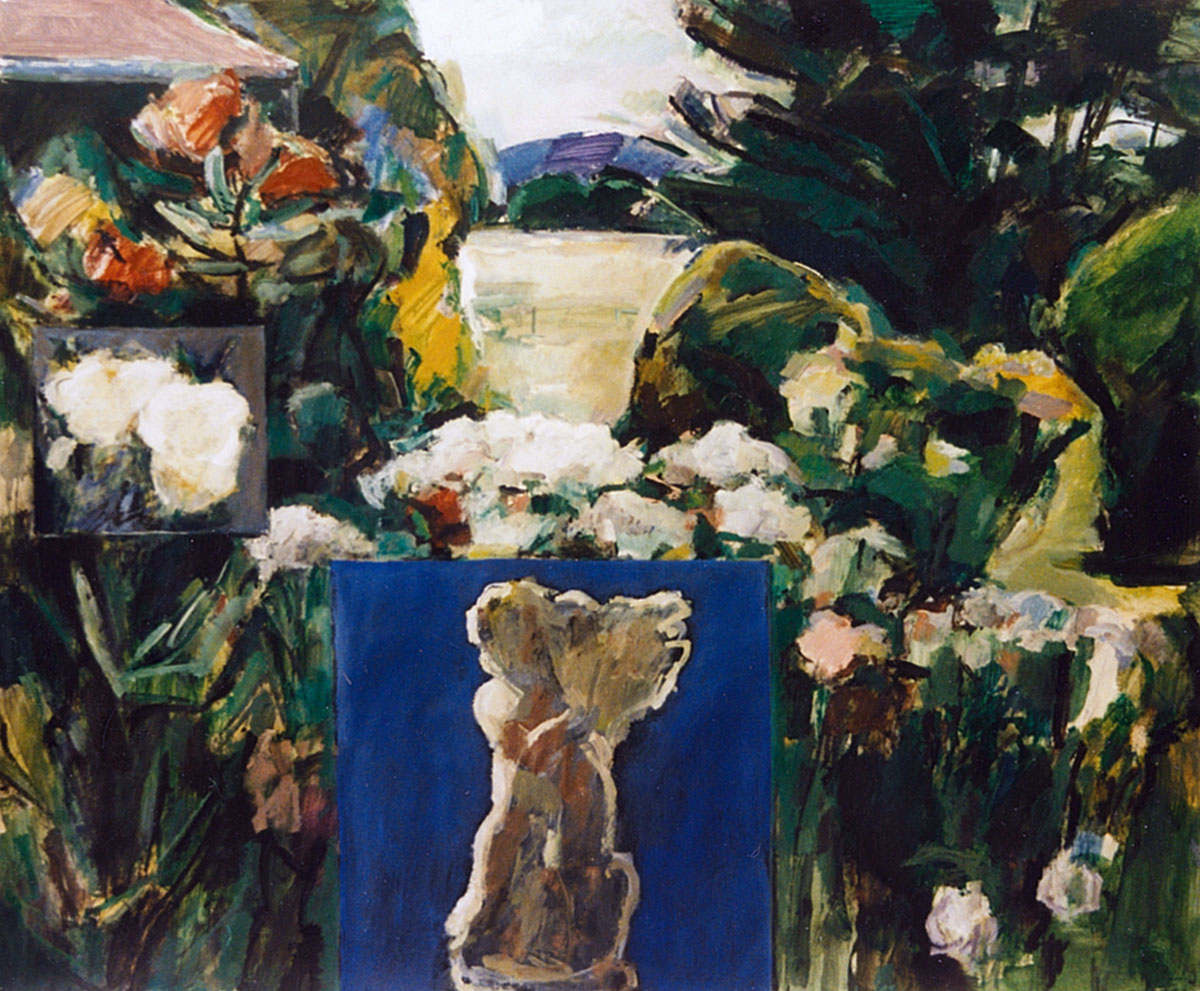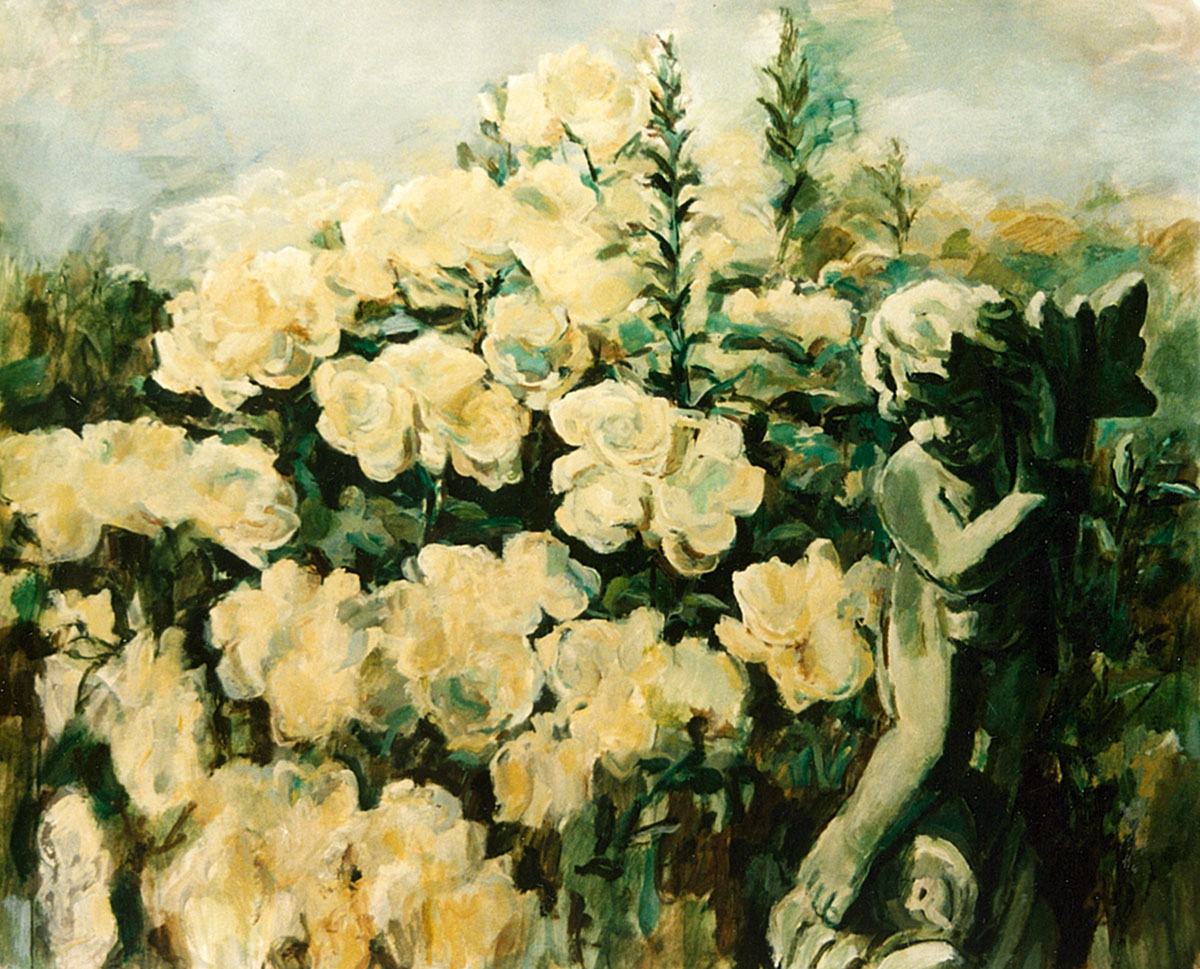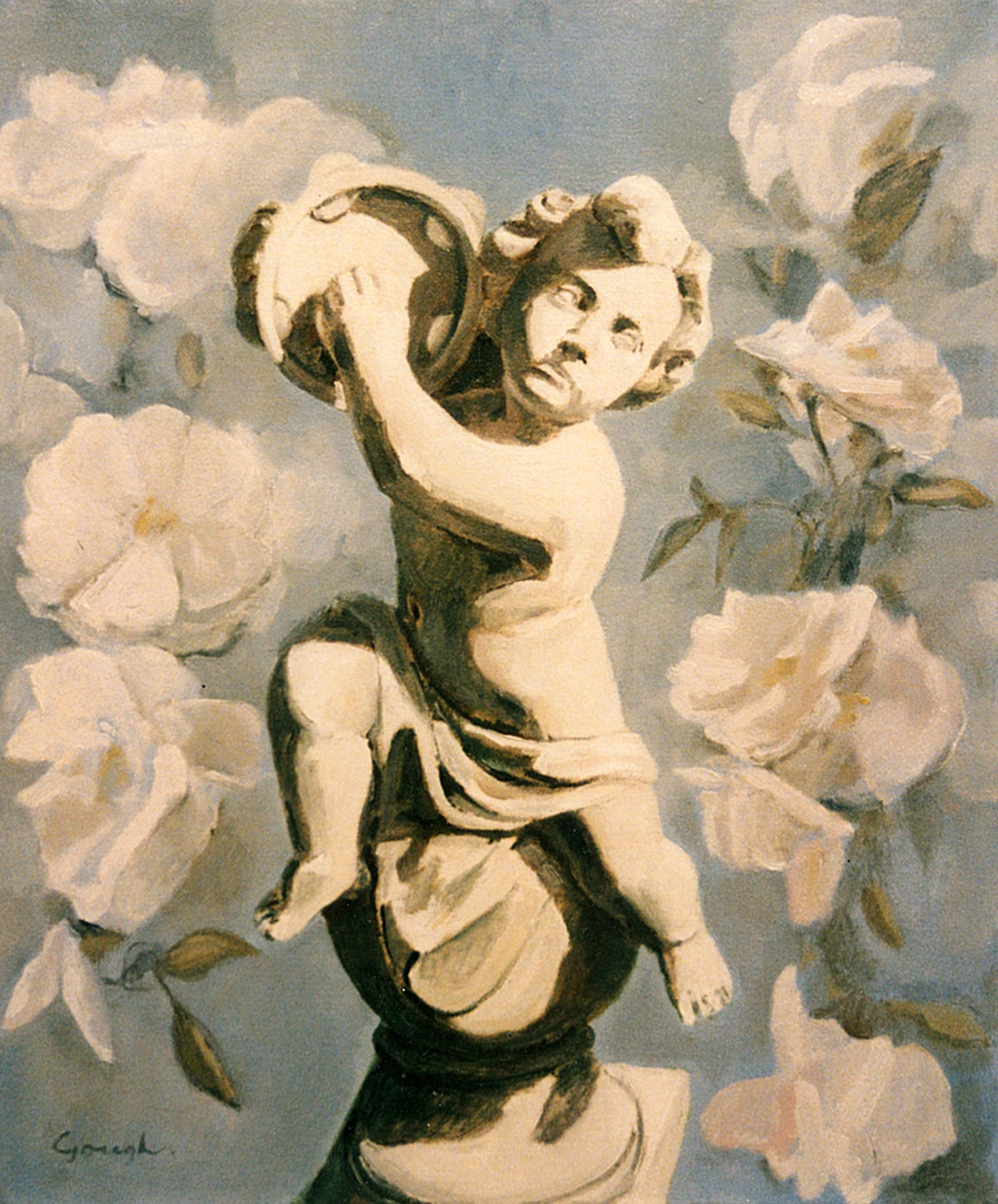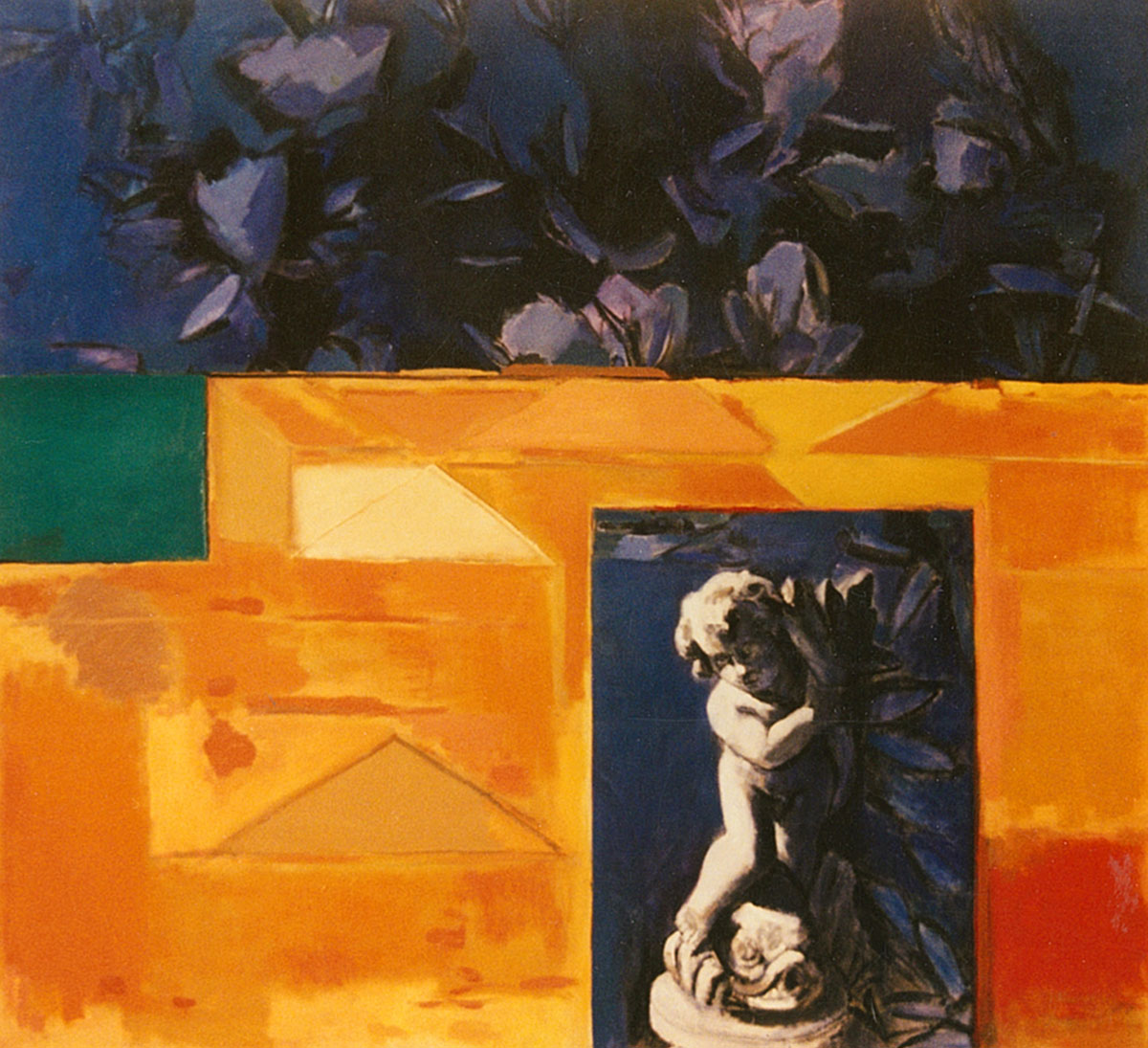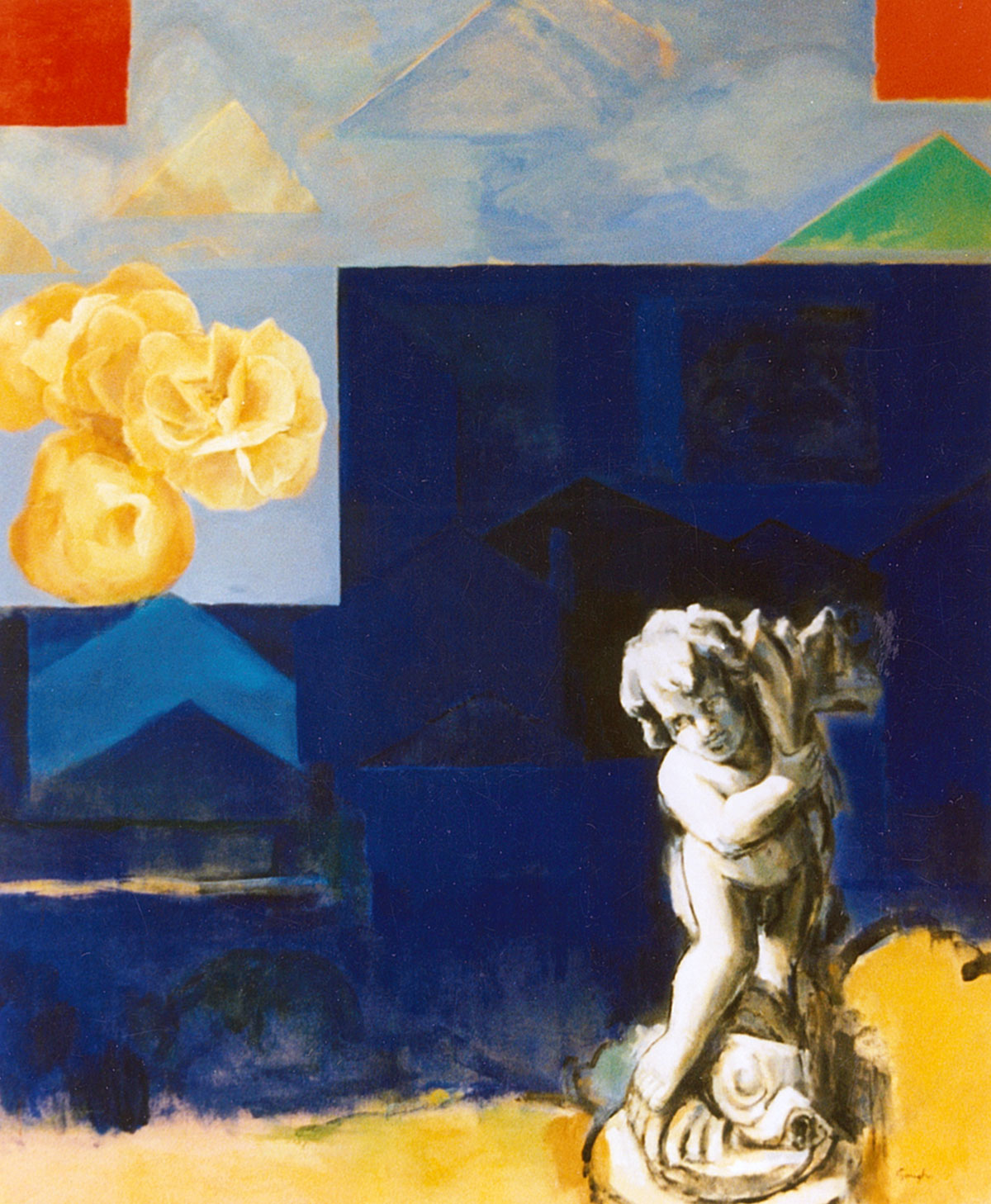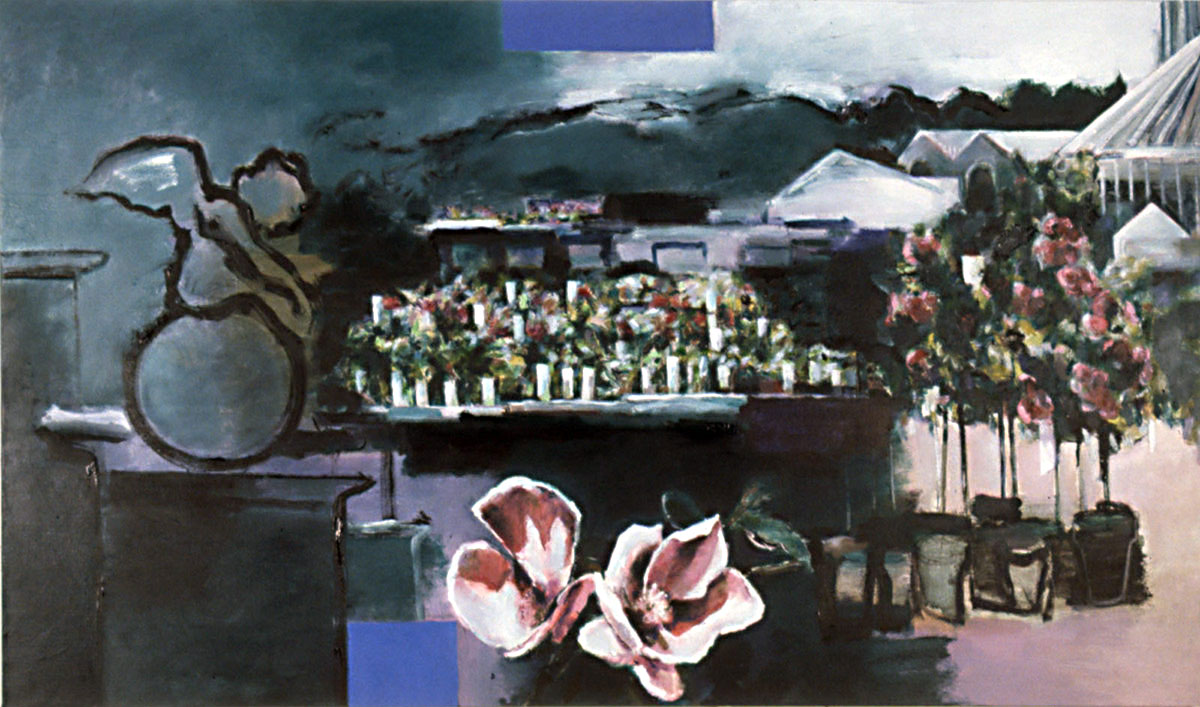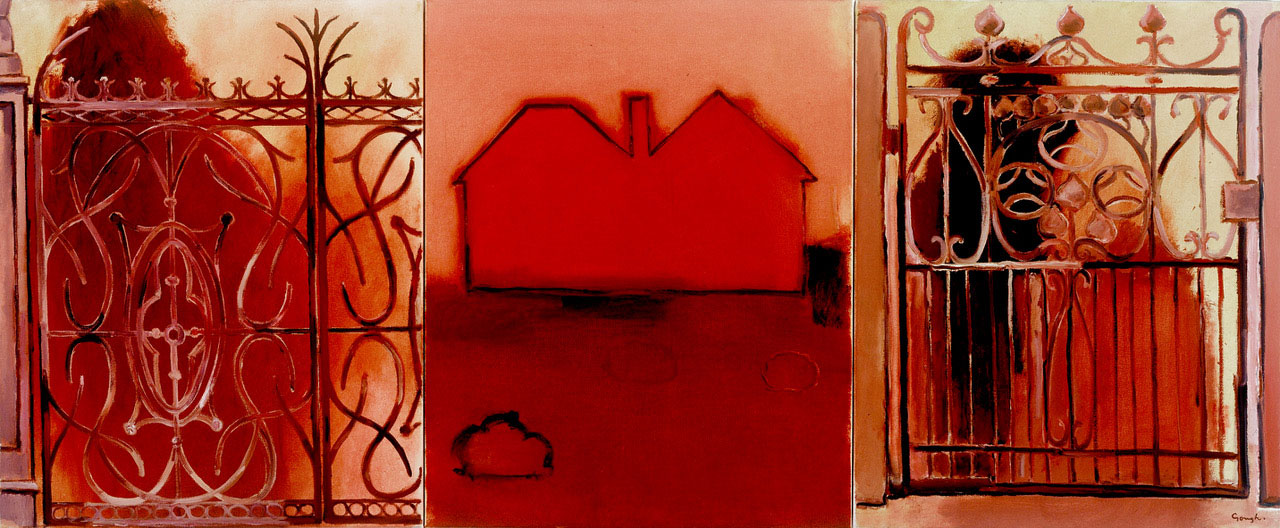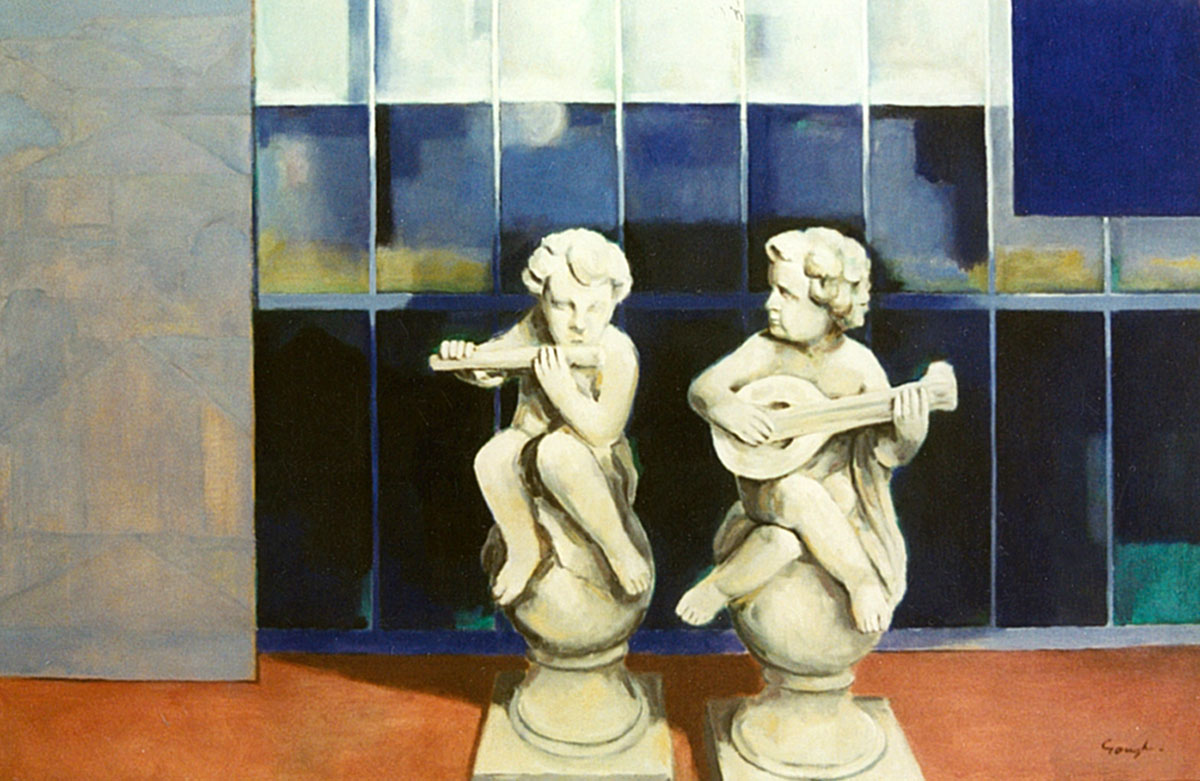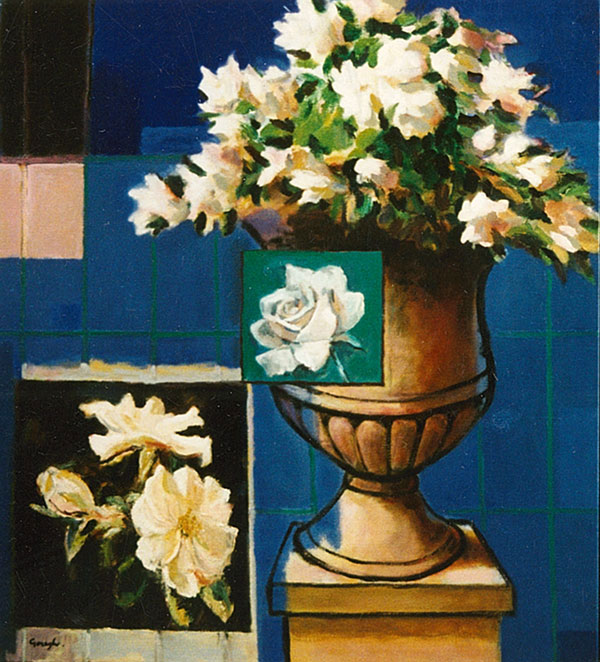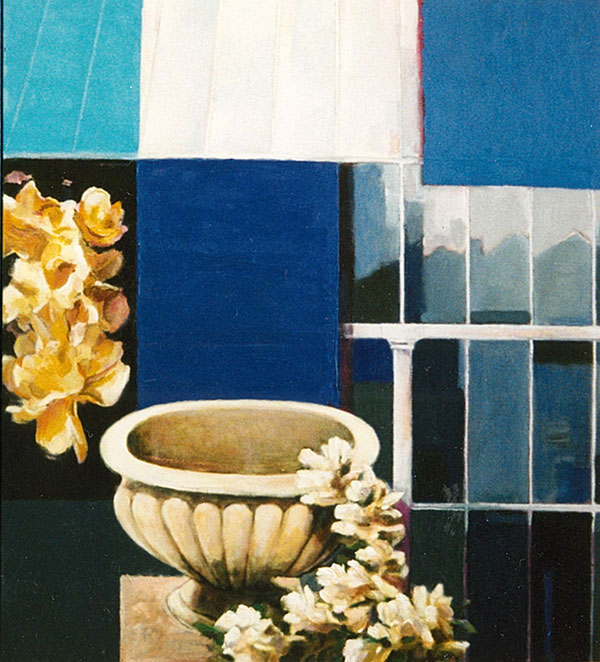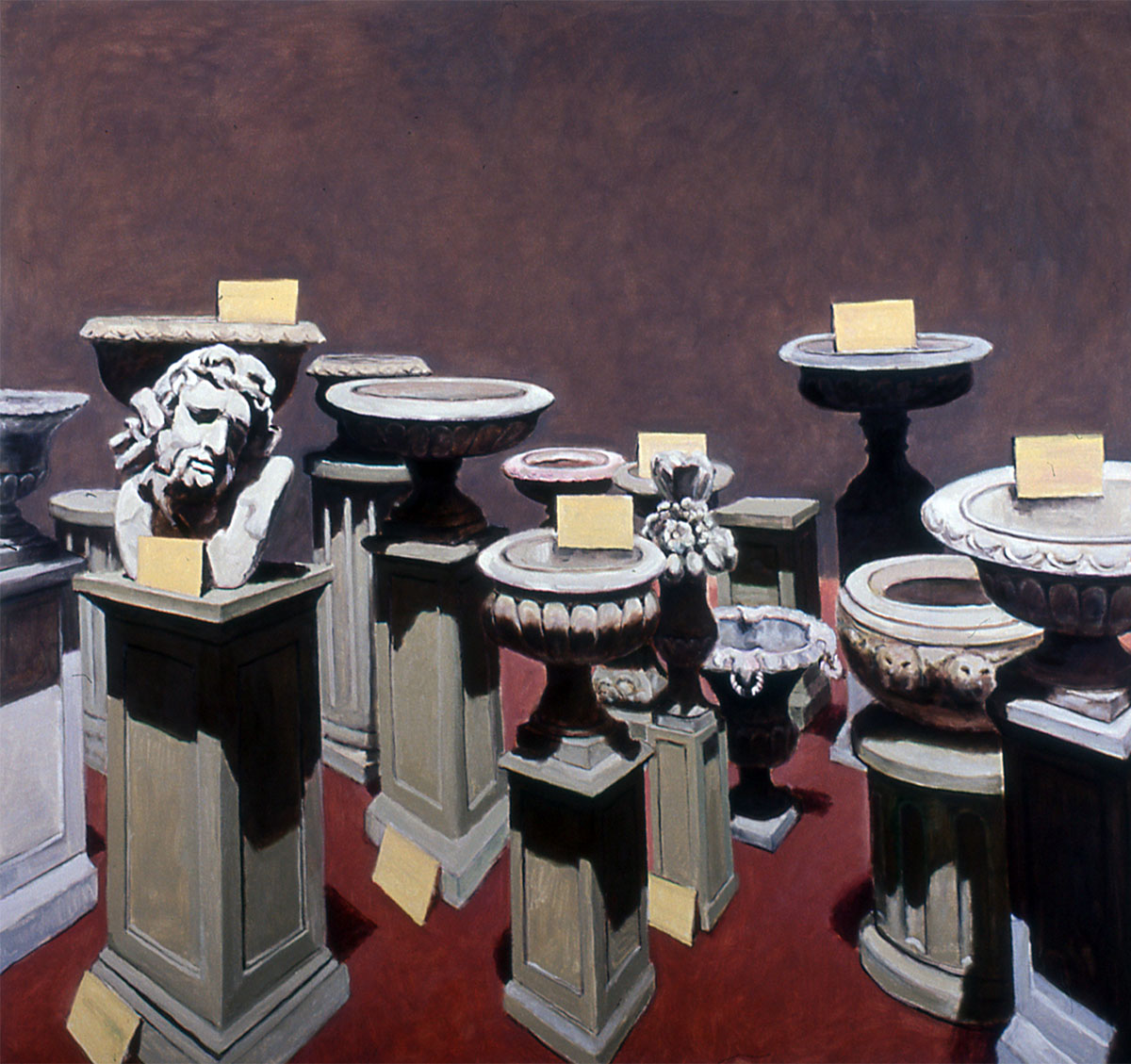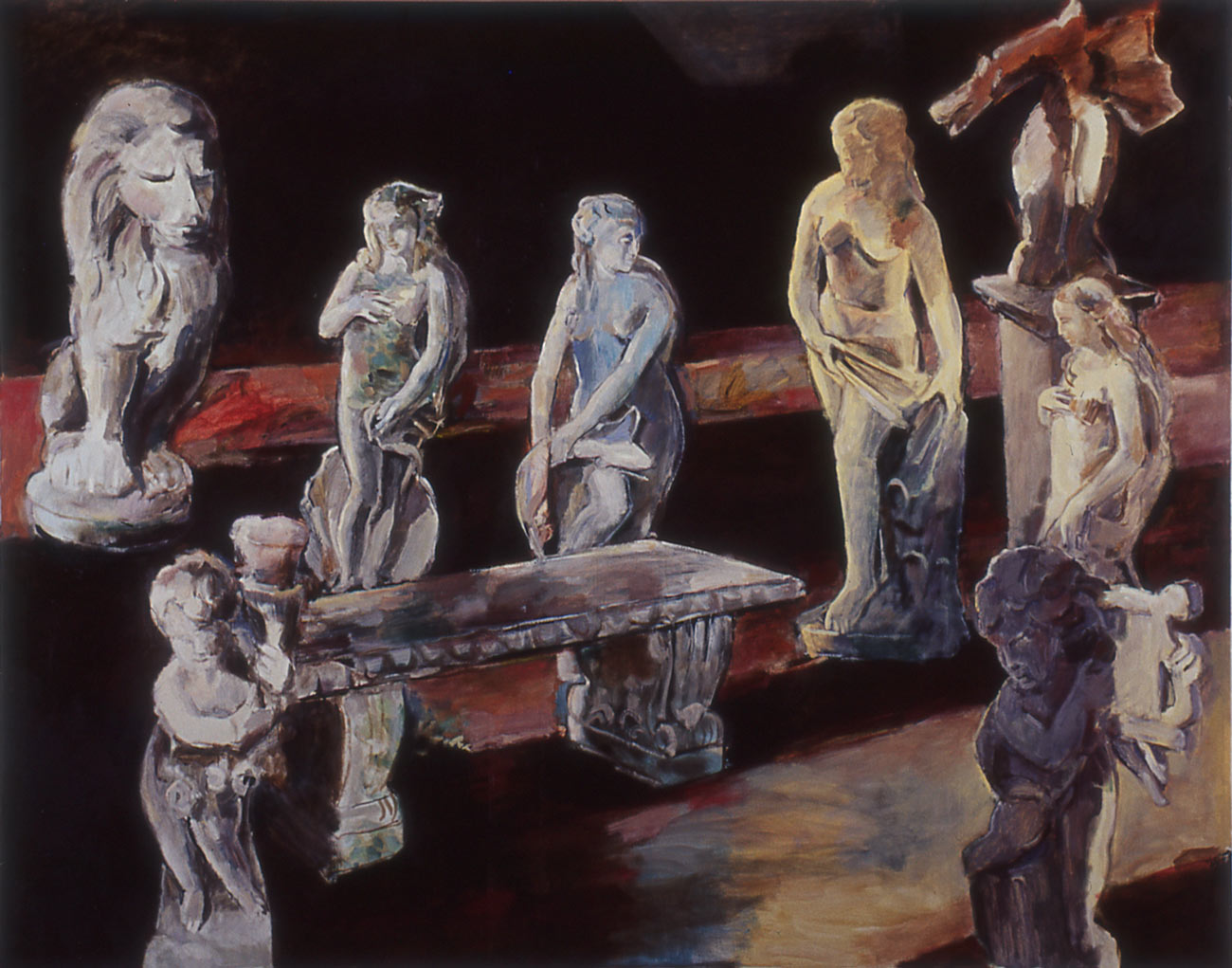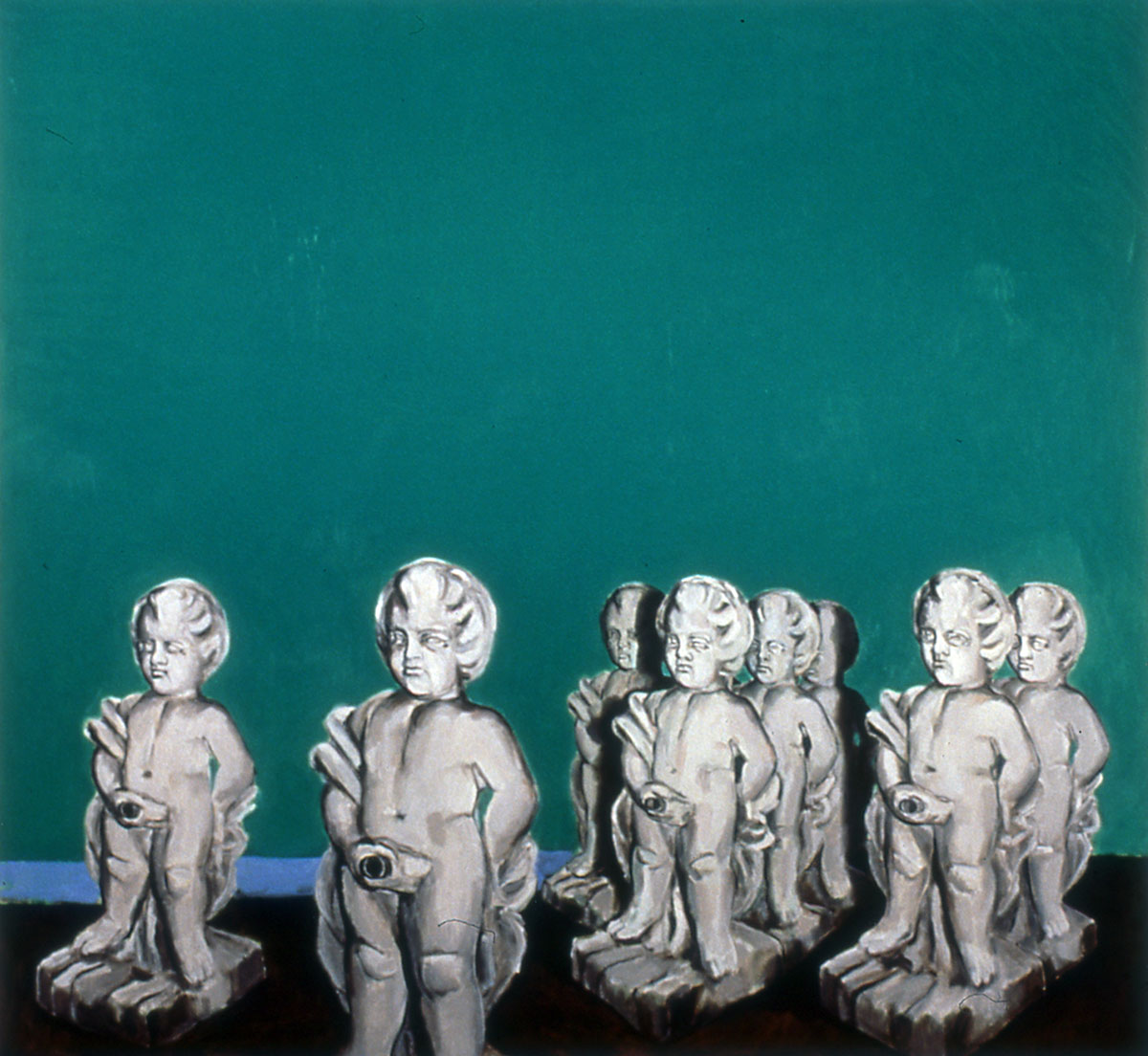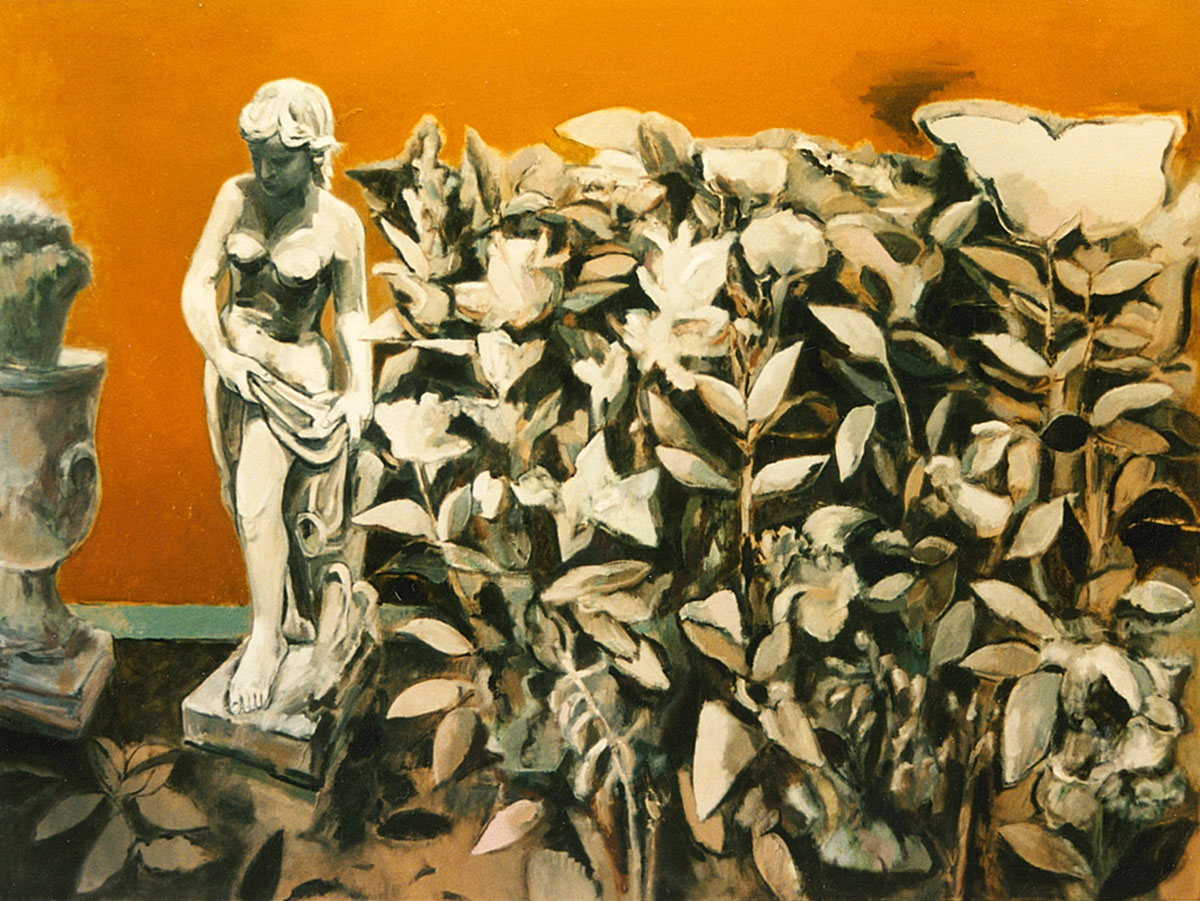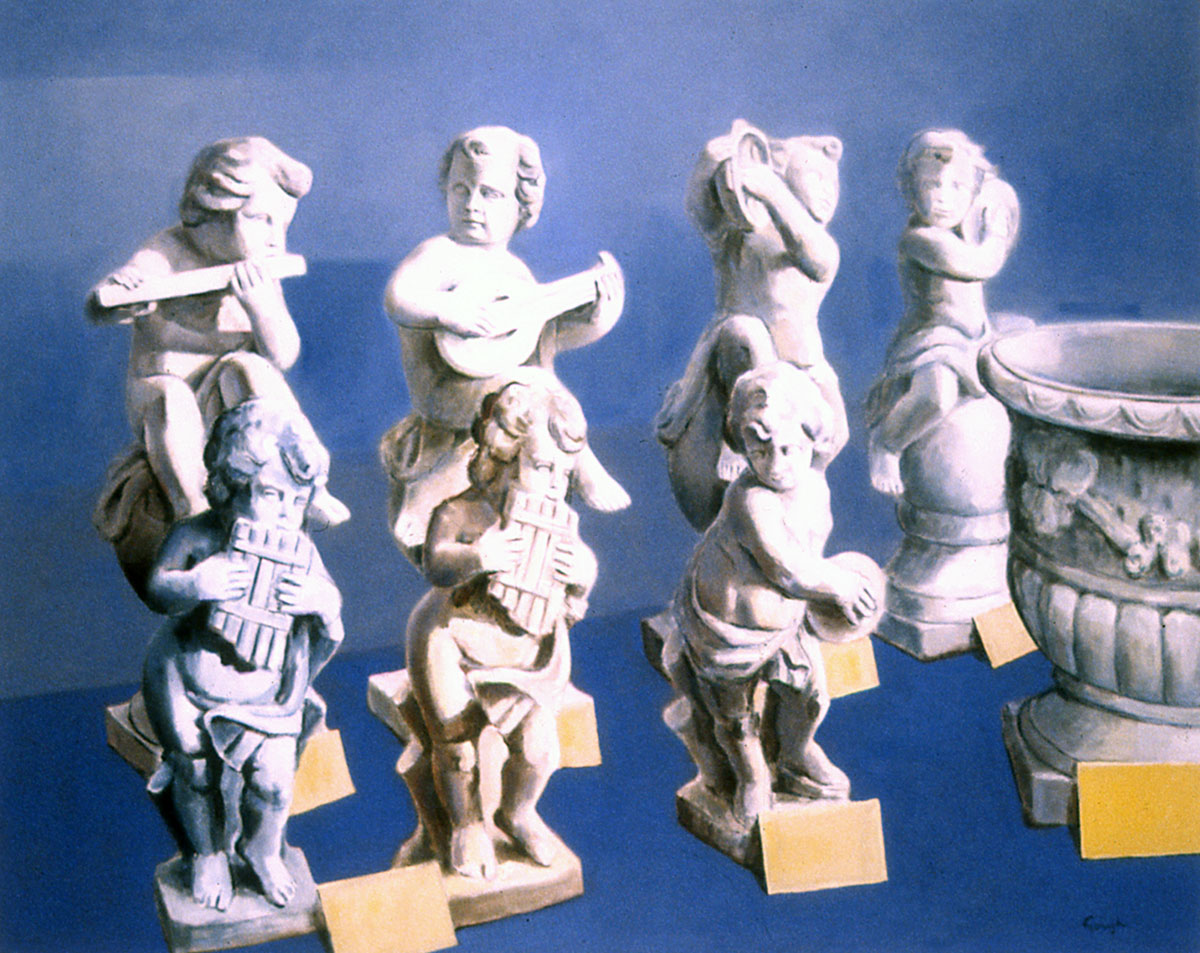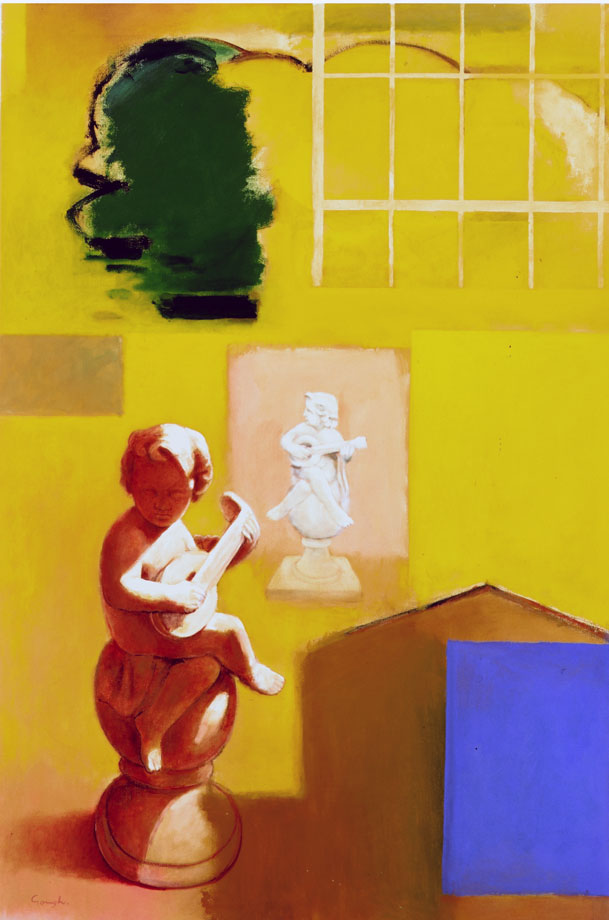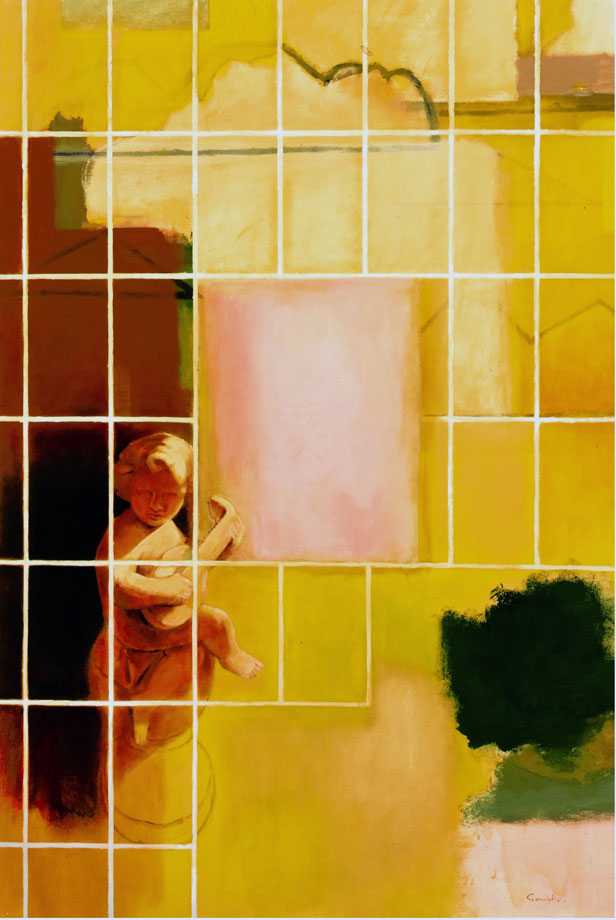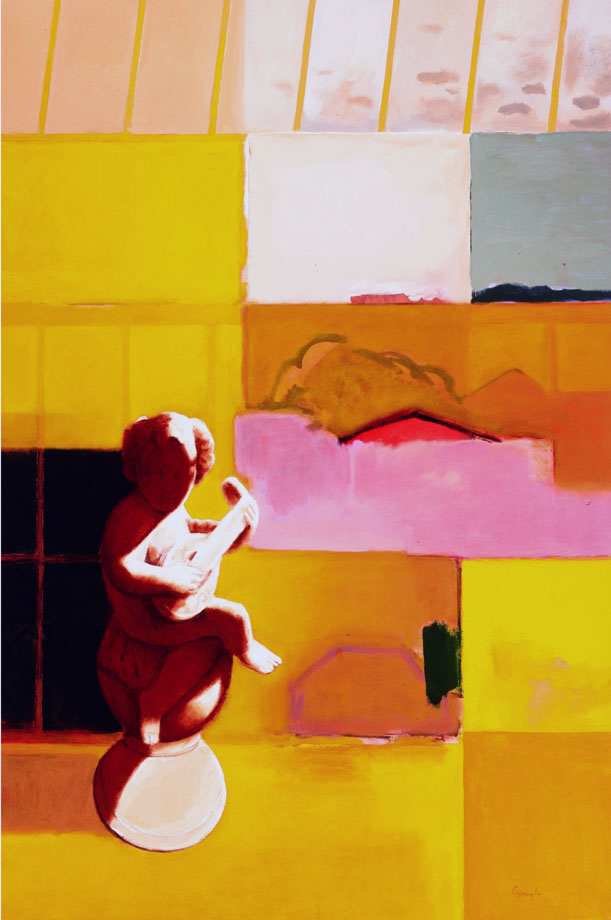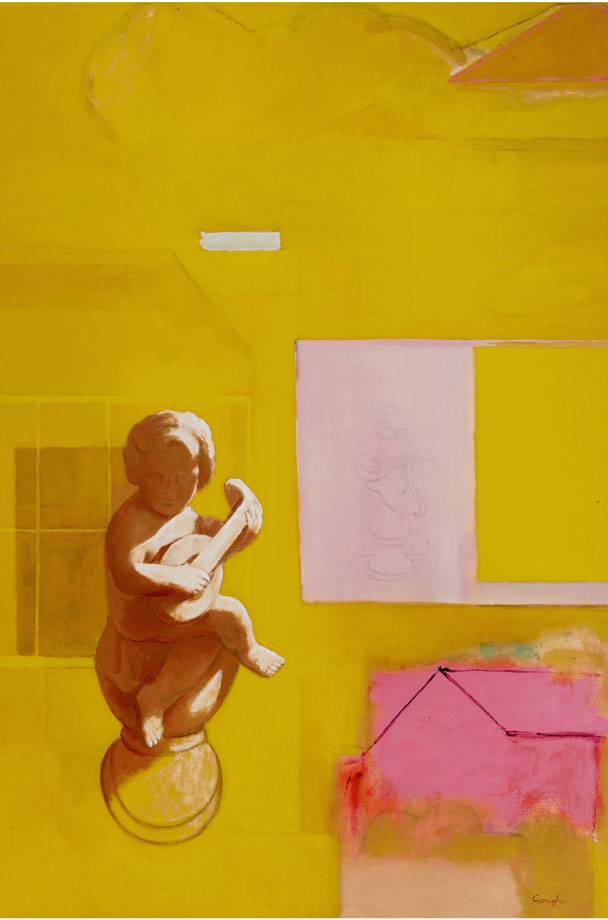Span Galleries, Melbourne, Victoria
Mar 28th 2000 – Apr 8th 2000
Perth Galleries, Perth, W.A.
May 26th 2000 – Jun 13th 2000
Click to Read Patrick Hutchings’ Essay
La Trobe University – Phyllis Palmer Gallery,
Bendigo, Victoria Feb 27th 2002 – Mar 28th 2002
La Trobe University -Bundoora Homestead Gallery, Victoria
Aug 22nd 2002 – Oct 6th 2002
Penny School Gallery, Maldon, Victoria
Feb 15th 2003 – Mar 15th 2003
SUBURBAN GARDEN WORKS
Works in these exhibitions were concerned with variations on the theme of suburban gardens, where I was having an ironic dig at ‘suburban’ taste. Two aspects were involved…..(a)where I was following on from an earlier series,
‘No Junk, Mail?'(1995-8)…… and (b) the cultivated and stylized gardens; the ‘Tuscan’ look of new suburbia.
Junk mail has generally trashy, crammed layouts as consumerist enticements…..’bargains to be snapped up before they all go’…! Products are illustrated all over the page, in a kind of grid format with each competing for attention. Rectangles are used highlighting these bargains with prices and statements……..’this weekend only’…….. ‘these prices
will never again be repeated’………. etc. Repetition over all the pages of the brochure in gaudy colour, heightens the effect.
The ‘cultivated garden,’ now has oversized urns and pots copied from Greco-Roman examples, plus various types of statuary(cherubs, nymphs, dragons and maidens), water fountains, birdbaths and the like, looking somewhat inappropriate in an Australian context. This seems especially amusing when seen dominating the front yard of a modest weatherboard dwelling with the accompanying topiary, box hedges and heritage roses, and at the rear, near the barbecue and clothes hoist.
At the time, there seemed to be a plethora of television gardening shows that encouraged D.I.Y. homeowners to update their homes. ‘Backyard Blitz’, ‘Burke’s Backyard’, ‘Garden Makeovers’, ‘Ground Force’, ‘Gardening Australia’ and others. The Australian quarter acre block has come a long way from having a backyard where you could kick a football, play with bat and ball, chase the dog or collect eggs from your own hens right down at the back, near the vegetable garden.
Gardens are now more streamlined…almost sterile…on smaller areas of land as the houses are built much larger (and blocks of land are sold smaller). The ‘courtyard’ is fashionable with garden statuary, accompanied with other consumer products used to ‘civilize’ the total environment of the garden.
In these paintings of mine, a stylized ‘house motif of very modest form, appears(in some) as reminders that these works are about ordinary suburbia, rather than grand palaces on large estates. There once was a time when such statues were considered to be ‘kitsch’ when used in this manner. I have deliberately flirted with this notion, in the thought that by making paintings with them, that maybe I could turn them into art??? Kitsch is a very vital force in our culture. It has such a lot of energy that seems lacking in some high intellectual art.
In my continuing practice as an artist, I have selected these motifs from everthing that is out there in my visual world.
Lately it has been the garden, which seems to offer much. By taking sometimes only a small aspect, then investigating many ideas about it, I find that I am constantly challenged by possibilities, when I do something with it, then something else, then something else etc. etc.
The Work so Far
New New Images by Craig Gough
Take your garden ornaments to Florence: put them in a Hopper!
Note for an exhibition
Craig Gough’s recent exhibition at the Span Gallery, in Flinders Lane in Melbourne’s ‘art street’, renewed and deepened the images which he first offered the public in his ‘No-Junk Mail!’ show at the Christine Abrahams Gallery in the mid 1990s. Of that exhibition a Herald-Sun critic wrote:
OFF THE wall
Gardeners will either love or hate Craig Gough’s new paintings. In any case, if you’ve ever been mailed a garden shop catalogue, you’ll recognise his source material. Here are cheap concrete statuettes, ladders, flower pots, gazebos and all the other accoutrements of the garden industry, collaged together like a real advertising leaflet and overlaid with brightly coloured squares. Wickedly funny and clever to’ boot. At Christine Abrahams Gallery, 27 Gipps Street, Richmond until April 20.
Herald Sun, Tuesday, April 4, 1995
The ‘wickedly funny’ has become by 2000 deeply lyrical, and full of a still pathos. This development was always there, latent in the earlier paintings. One large -work in the recent Melbourne show arranged a row of cementputto statuettes on a background of blue-grey: and they suddenly looked like the figures on Luca della Robbia’s choir loft in the Museo del Opera del Duomo in Florence. One uses ‘looked like’ in a Post Modern sense, but the allusion holds up. For all that, della Robbia’s splendid marble variety of figures has been reduced to a repetition of just two or three types of cement figure, over and over putto, putto, putto, putti, putti, putti. The mechanised feel of the dying twentieth century is both caught and commented on -unkindly -in a painting which at once links and ironically divides eras of art. The amplitude of the Renaissance meets the ‘all too much’ of the mass-produced stuff which surrounds us. In the present Perth exhibition Concrete Choice (oil on canvas, 1999, 182 x 197cms), ‘bookends’ the musical putti between two urns, (with price ‘tickets on them?), and the canzone becomes florid, florid blooms in a greyish sky.
Top right of the composition is a schematic gable-end view of an ordinary -very ordinary Melbourne suburban house. In Suburban Fountain (oil and acrylic on canvas, 1999, 91 x 122cms), the logo house/house logo and the acanthus-leaf-bearing child are very nearly in ‘naturalistic’ scale; but the house is a stark black shape, while the putto is lovingly detailed. In Suburban Fountain Number 3 (acrylic on canvas, 1999, 91 x 122cms), the same cement figure is seen in close-up in the bright foreground of a broody background with, again, the logo house now somehow suggesting a whole suburban street. In the present Perth show Weathered Putto (oil on canvas, 1999, 56 x 51 cms), is in close-up portrait mode, and the painter gives the dull cement a nearly-human pathos. The empty cornucopia which came as part of the garden ornament heightens the reverse, pathetic fallacy of the painting. Here not Nature, but an indifferent artifact, is made to reflect human passion and feelings -just as a fine high-art one would. The painter transforms -as ever -the motif.
Blue Putto (oil on canvas, 1999, 56 x 46cms), has the figure’s lumpish play on the tambourine turn into musical flowers in the pale blue-grey air. Melbourne skies these pictures all have: not the high summer blue of Craig Gough’s birthplace.
In the recent Melbourne Exhibition another putto, caught on a square of pinkish-blue grey, looked like a detail waiting to go into a Hopper which Edward Hopper never got ’round to painting. There is a kind of haunting emptiness around the figure, waiting to slide into a larger volume of just the same kind again of emptiness. Some people have found Gough’s light Hopperesque, and this is right. There are, too, similar -but not identical -uses of space; space is not so much what things are in, as a vacuum surrounding them.
Flower Paintings
The Christine Abrahams catalogue of 1995 has as epigraph to its critical essay:
‘May I paint flowers?’
‘Only if they are in quotation. ‘
Gough’s highly attractive smaller flower pictures quote the flowers themselves, directly -and remind us of other flower paintings: a genre as vast – by now almost -as the nude. Flower paintings abut the other genre called in Italian natura morta, and in French, nature morte: which is just what flower paintings are not. The irises in the present show will -if picked and placed in a vase -wither in the studio. The painted ones will glow on. Art is: nature twice.
Flower paintings abounded in the Span Gallery show: big greenhouse arrays of them, with the glazing of the windows misted to heighten the sense of its all being, at a remove. If the 1995 works were ‘funny to boot’, the present ones have Wordsworth’s feel of ’emotion recollected in tranquillity’. Sunk deeper, now, into recollection the real-life and junk-mail arrays have gone deeper, emotionally. In the present Perth show Conservatory (oil on canvas, 2000, 182 x 197cms), avoids straight naturalism: naturalism looms behind three very deliberate foreground distractions. Suburban Gardener’s Choice (diptych, 1999-2000, oil on canvas, 182 x 314cms), anthologises most of the tropes that are in play in the Melbourne and Perth shows. Study for Suburban Ornament (acrylic on canvas, 2000, 60 x 102cms) is a theme-and-variation piece. The visual elements may endlessly be played/ploy’d with. Here the very canvas itself is made, as a plane, ambiguous by the counterpointing of tropes.
Consistently Craig Gough splices his basic realism with sly references to Mondrian, capturing a few of his squares, re-colouring them, and fitting them into floral contexts with ‘which they will not, quite square. And he sometimes embellishes these unexpected squares with the occasional house logo. Of course these squares are, at once, price labels/Mondrian’s sacred rectangles.
Art once lay in concealing art. Post-modernly, (in May 2000, Post Post-Modernly?), art now all lies/lies on the surface, concealing – as in Gough’s case – originality. Originality presents here under a mask of quotation, and of quotation-of-quotation, until Nature is so provoked that she punches through to assert herself.
Quotation is fine: but the best one-liners come from Nature, and after Nature, Art.
Craig Gough had a travelling Retrospective in 1995-96 which showed in the art galleries of Castlemaine and Warrnambool, the McClelland Gallery, (Langwarrin, Mornington Peninsula), and the Shepparton and Ararat art galleries. The series of works was notable for consistency of style and approach: a kind of staccato, almost nervous, graphic realism, broke through, again and again into painterly lyricism. Comparisons of the present show’s works with the illustrations of the travelling exhibition catalogue Craig Gough: Survey 1980-1990 show how Gough has continued his style-devices, and deepened his (and so our) understanding of the genial-but-doomed look of things.
For Craig Gough the world is a mostly O.K. place: but he keeps his eye on it.
Patrick Hutchings May 2000

